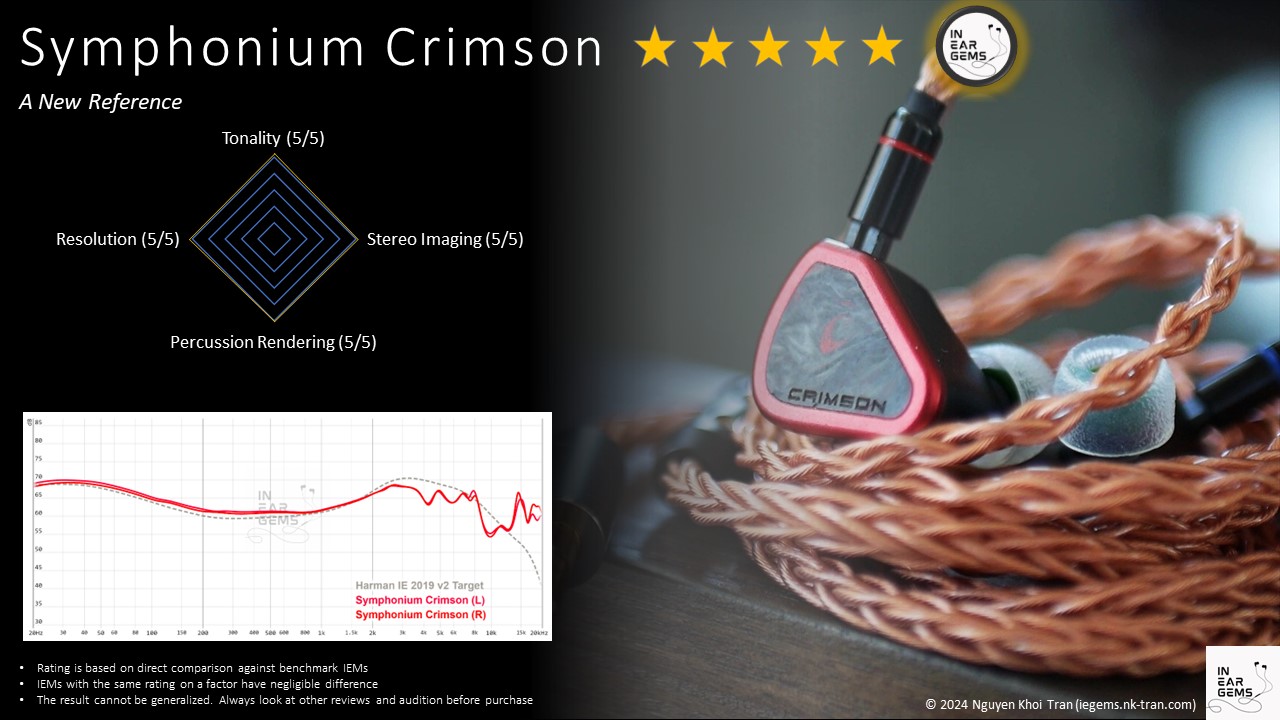Symphonium Crimson - A New Reference
There is an inherent beauty, a classical beauty, in doing things right. To optimise. To be efficient. To get the most out of the least.
Classically beautiful. That’s how I think about a new wave of IEM boutiques run by young teams with a strong engineering background and a good taste of aural experiences. A while ago, I have had the pleasure to test and write about Helios from Symphonium, a Singaporean IEM manufacturers whose pride is engineering excellence. In the following months, inspired by my experience with Helios, I added its budget-friendly sibling, the Meteor, to my small collection. Yet, despite all their merits, these IEMs have not fully resonated with me.
Now, Symphonium is back for the third round with their current flagship, the Crimson. Is this finally the one? Read on to find out, my friends.
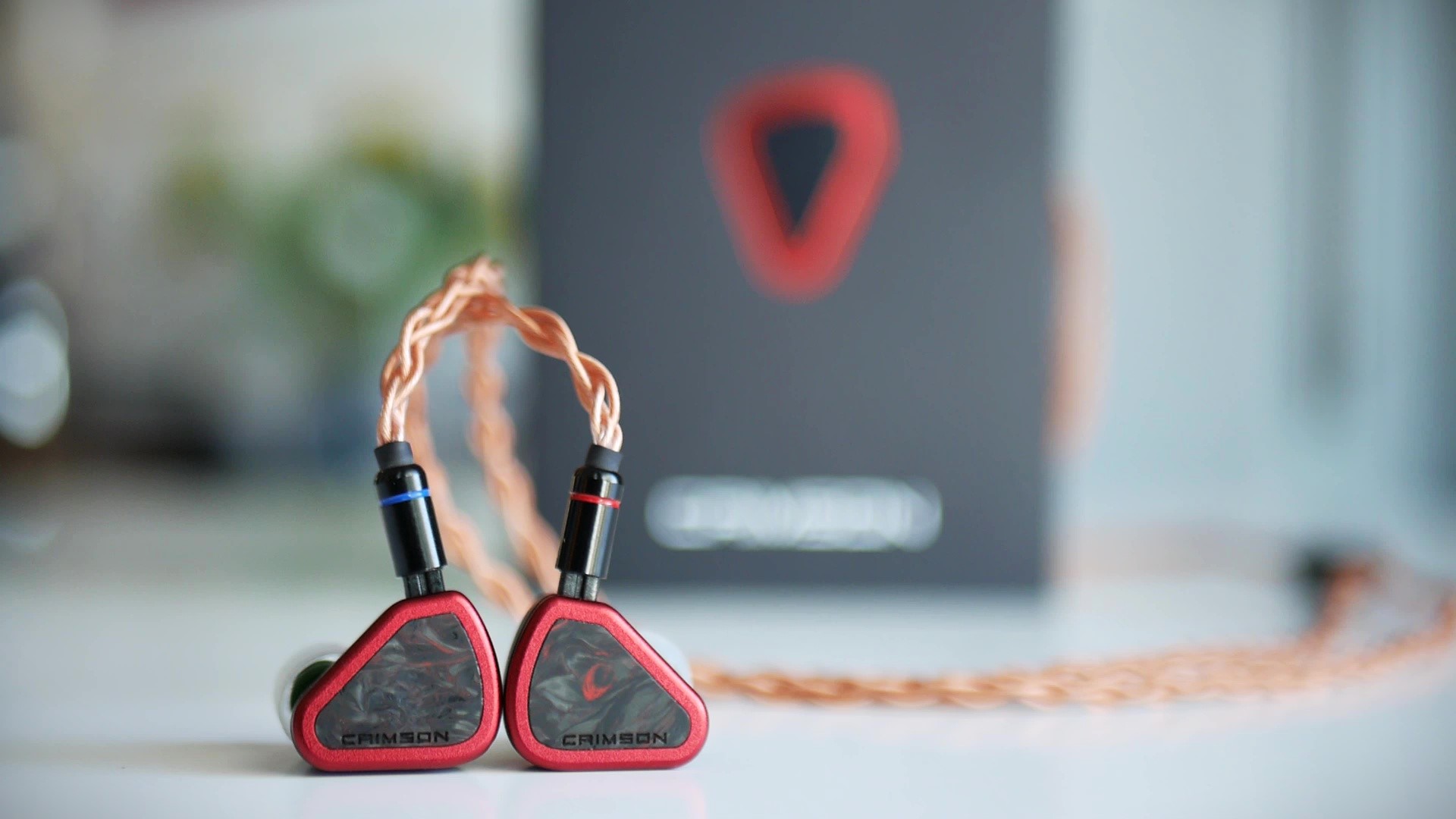
Forewords
- What I look for in an IEM is immersion. I want to feel the orchestra around my head, track individual instruments, and hear all of their textures and details. I’m not picky about tonality, as long as it is not make the orchestra, violin, cellos, and pianos sound wrong.
- I rate IEMs within with a consistent scale from 1 (Poor) to 3 (Good) to 5 (Outstanding). An overall ranking of 3/5 or above is considered positive.
- Ranking list and measurement database are on my IEM review blog.
- Terms used in my reviews are consistent with the glossary by Headphonesty
- This review is possible thanks to the Australian tour arranged by Symphonium and @Damz87 (Thank you!). I have no affiliation with or financial interest in Symphonium.
- The unit retails for $1499 (stock cable) and $1699 (upgraded 8-wire cable) at the time this review was published. Unaffiliated link: https://www.symphoniumaudio.com/products/crimson?variant=41361632788531
General Information
As of early 2024, Crimson is the flagship IEM of Symphonium, the best that they can offer.
Like most Symphonium IEMs, Crimson has four BA drivers and a complex crossover circuitry, all encased in a reversed tear-shape metal shells.
4 BA drivers, you ask?
Yes. Crimson has 4 BA drivers, just like Helios and Meteor before it. Yet, these IEMs sound quite different in both tuning and technical performance.
Some familiar technologies from Helios and Meteor make a return with Crimson:
- TrueX 4-way Crossover: fancy techy way of saying that the crossover circuit of Crimson splits the incoming signal into 4 parts to feed 4 drivers, ensuring that drivers contribute energy within their optimal range with minimal overlapping. This technology first appeared in Helios. The Meteor uses a simpler version with only 3-way crossover.
- Featuring Filtered Linear Attenuation Tuning (FLAT): a fancy techy way to describe a circuit to ensure that the impedance curve of Crimson is linear. Whilst most IEMs with single dynamic driver has a flat impedance curve, multi-driver IEMs tend to have a lot of up and down between 20Hz and 20kHz, causing undesirable changes in frequency response with swapping between amplifiers with different output impedance. Similar technologies also appeared in 64 Audio IEM (LID circuitry), Fir Audio, FATFreq, and a few other manufacturers. Both Helios and Meteor have this technology.
- Phase Harmonic Attenuation Technology (PHAT): little details are available about this technology, besides the fact that it was developed to make the treble extension of Meteor possible. As far as I understand, this technique aims to reduce nozzle size by removing acoustic tubes whilst avoiding phase cancellations problems that ruin a smooth and extended treble response.
Do these technologies work? We will discuss in more details in the sonic performance section.
Before moving on, let’s quickly talk about packaging and accessories. Again, little has changed since Helios.
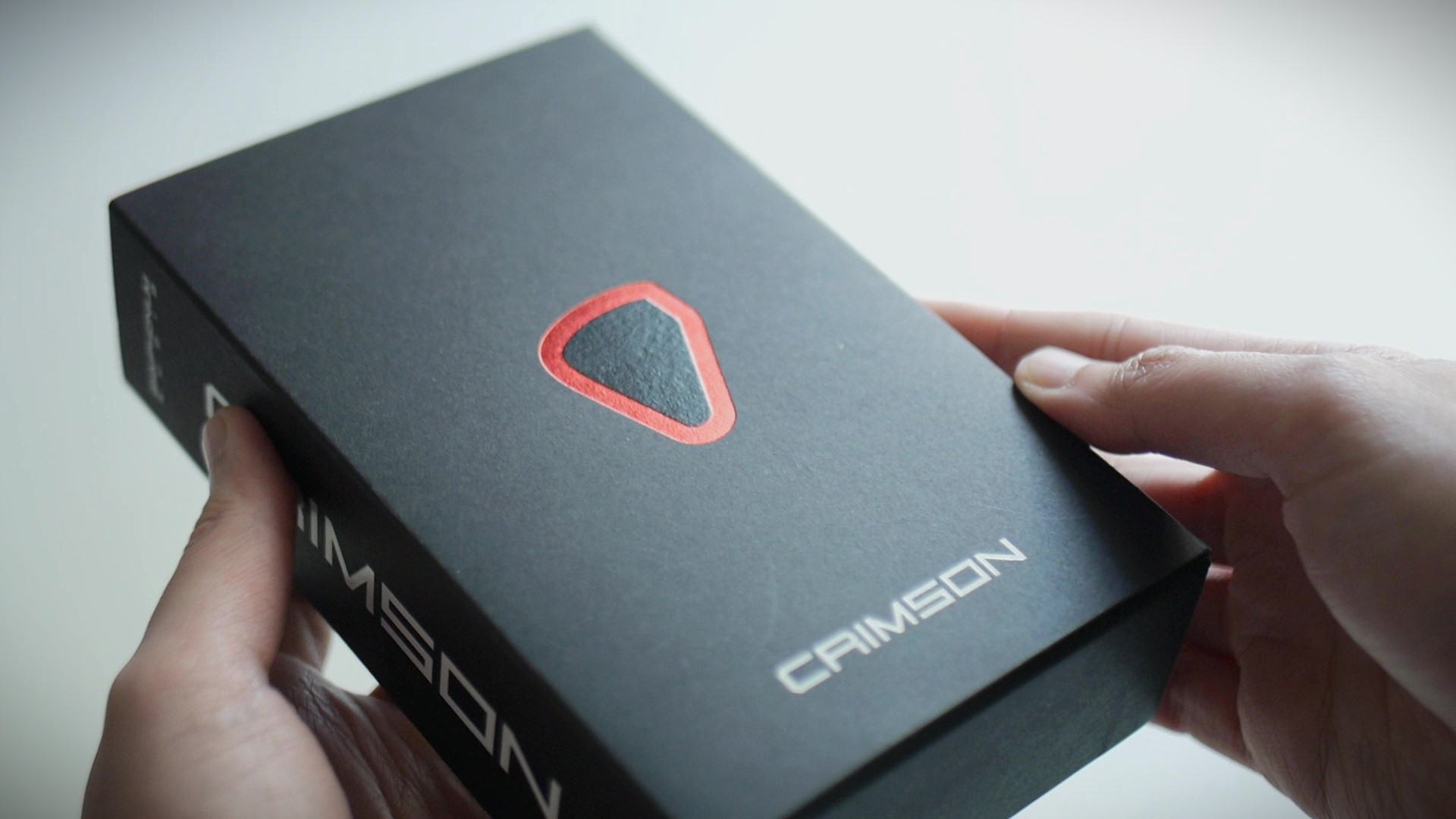
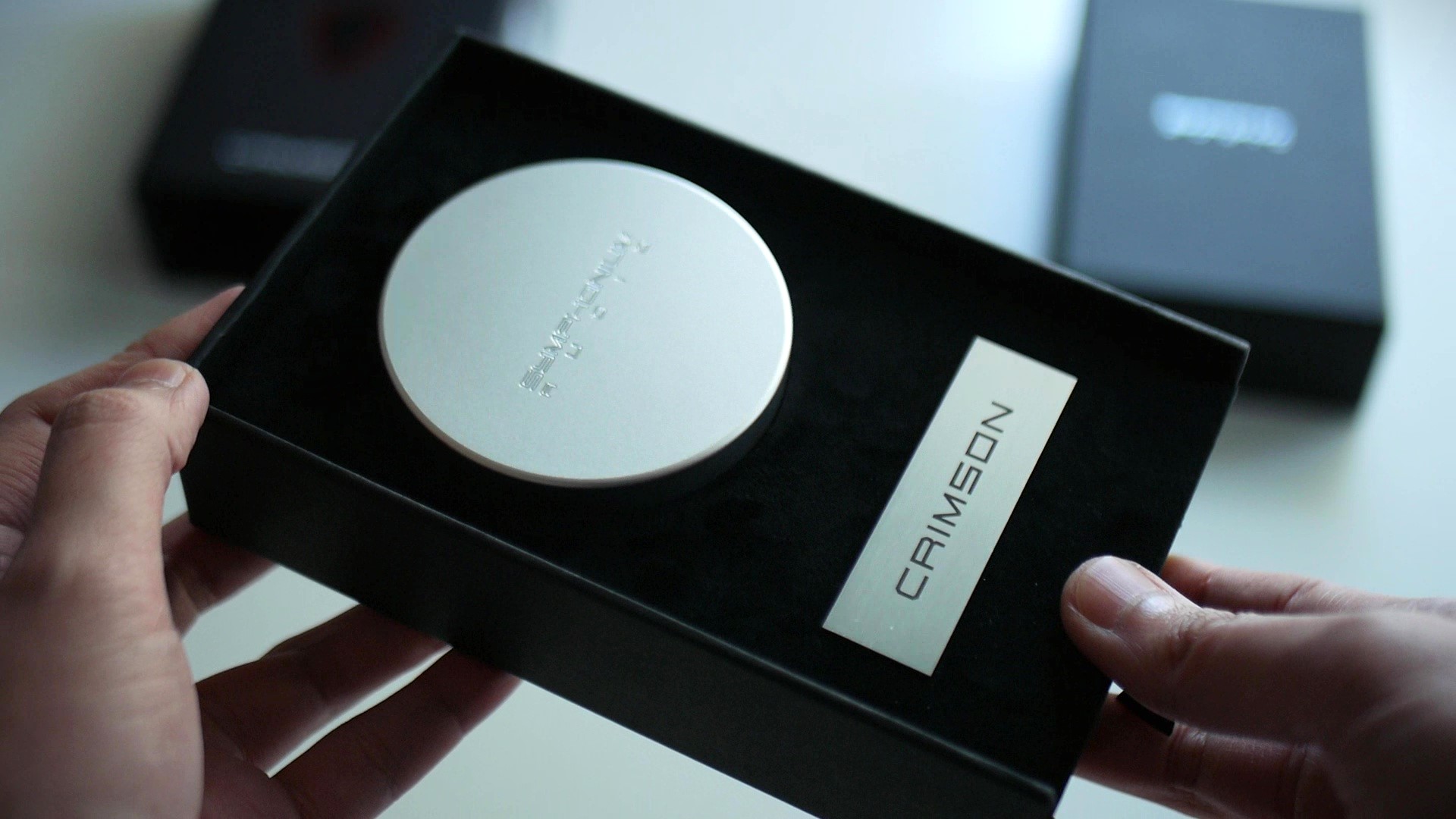
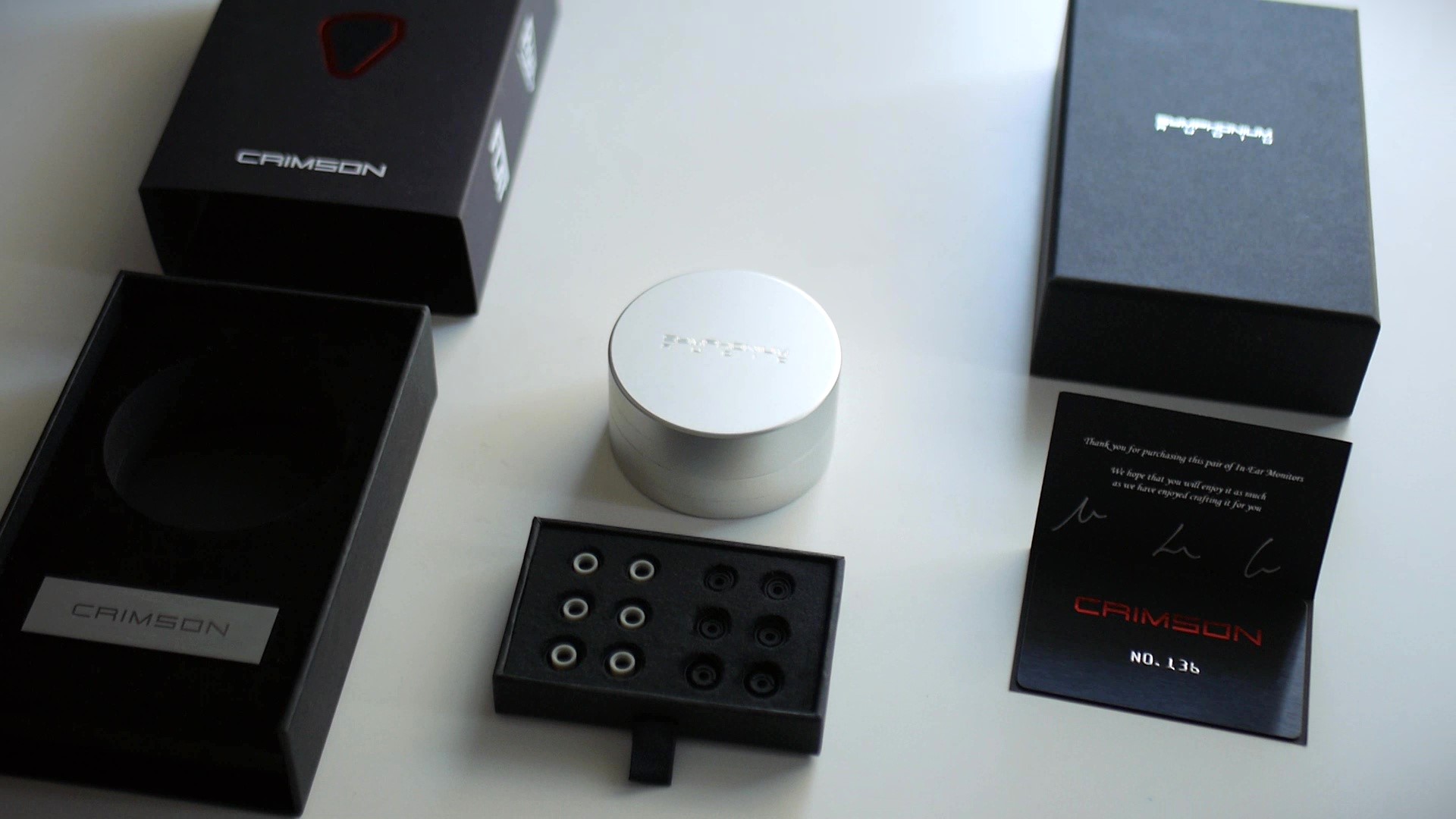
Crimson comes in a surprisingly small box and stored in a surprisingly small metal case. Inside the case, you can find the IEM itself and a cable of your choice.
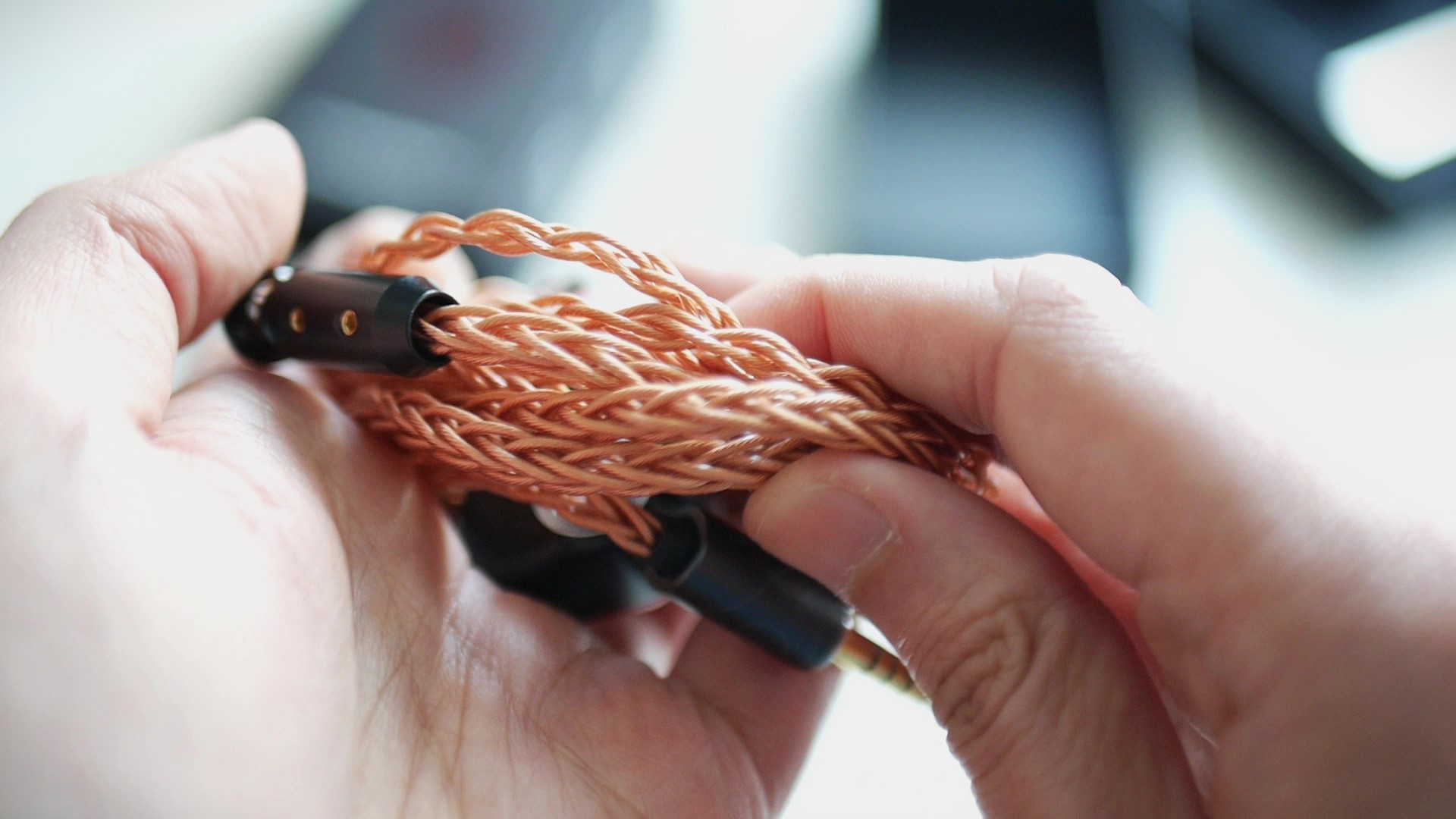
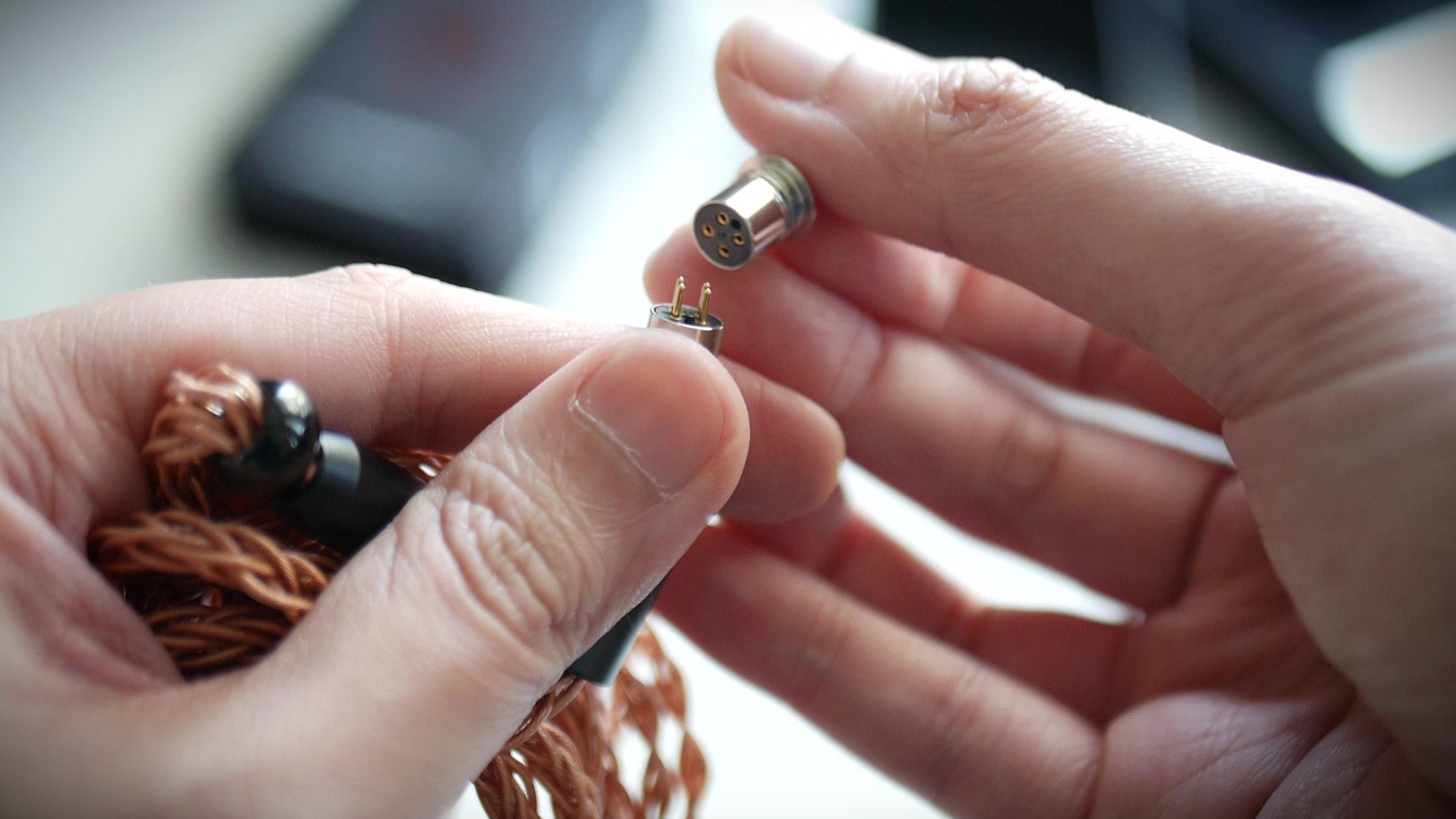
My unit came with the upgraded 8-wire cable with interchangeable plug. Despite having 8 wires, the cable is supple and very well behaved. The thickness of the cable also matches the size of the earpieces.
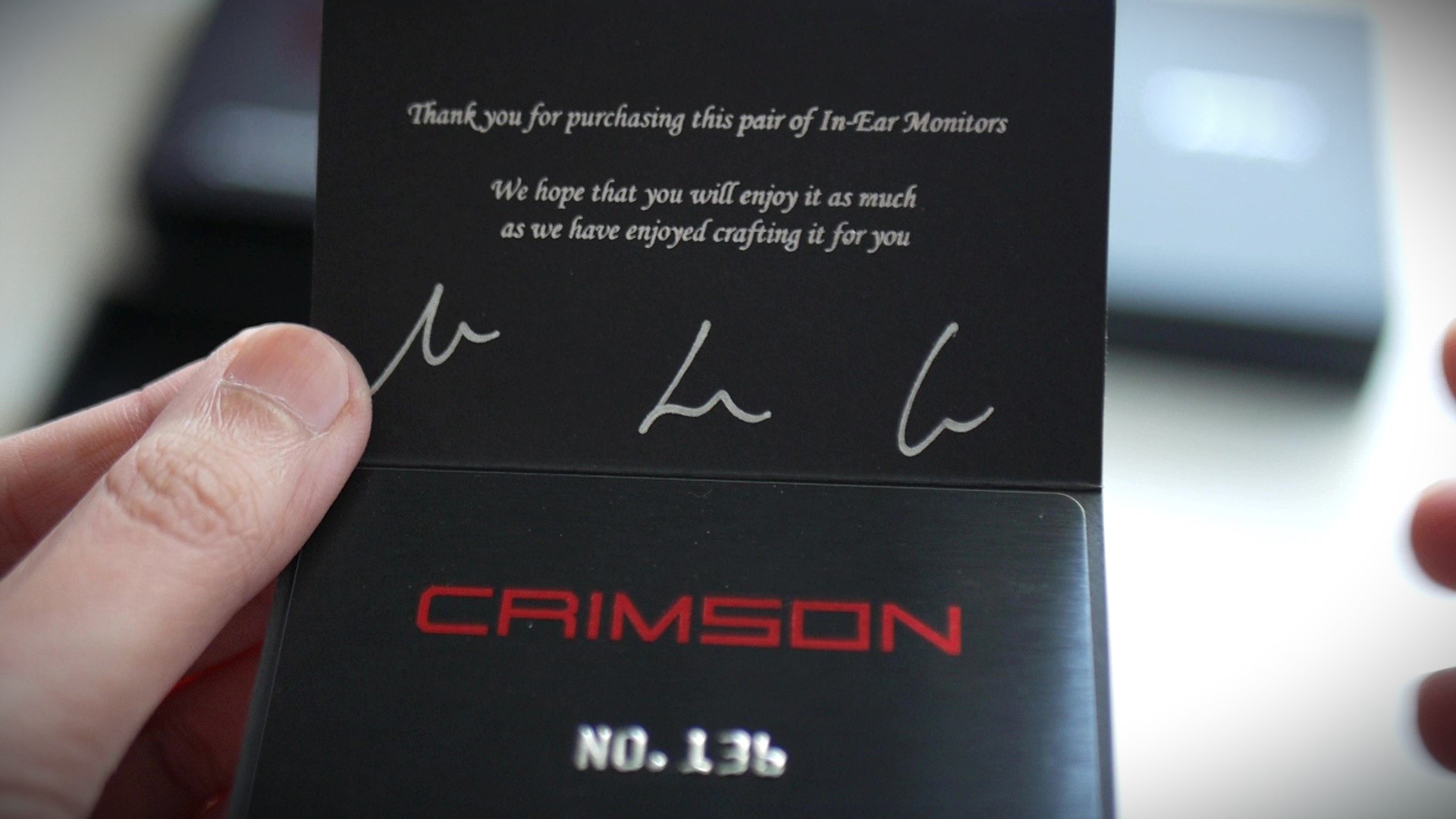
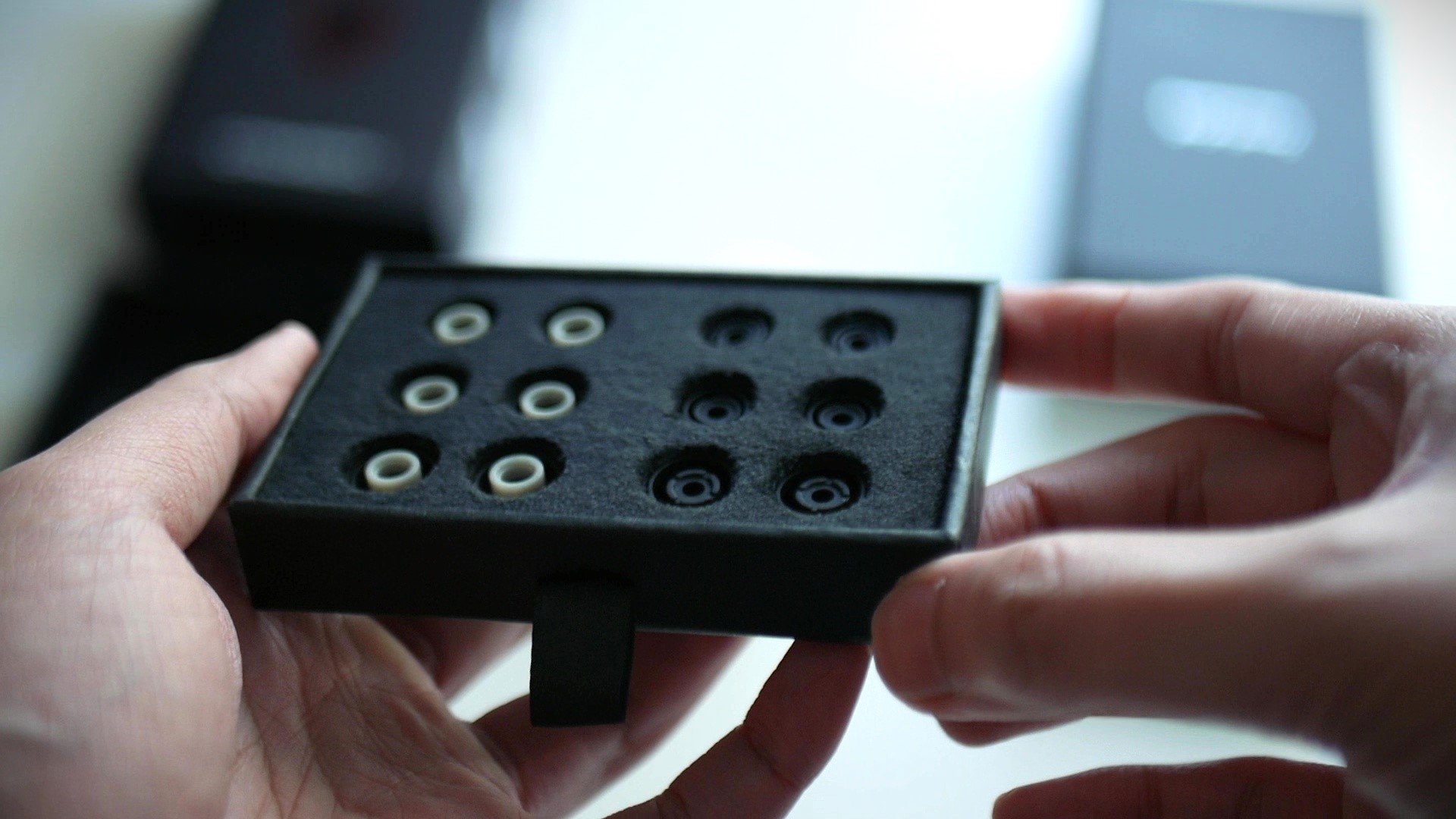
At the bottom of the box, we can find a drawer that contains two types of quality ear tips (Azla SEDNA and Divinus Velvet) and and a warranty card with signature from Symphonium team members.
Physical Aspects
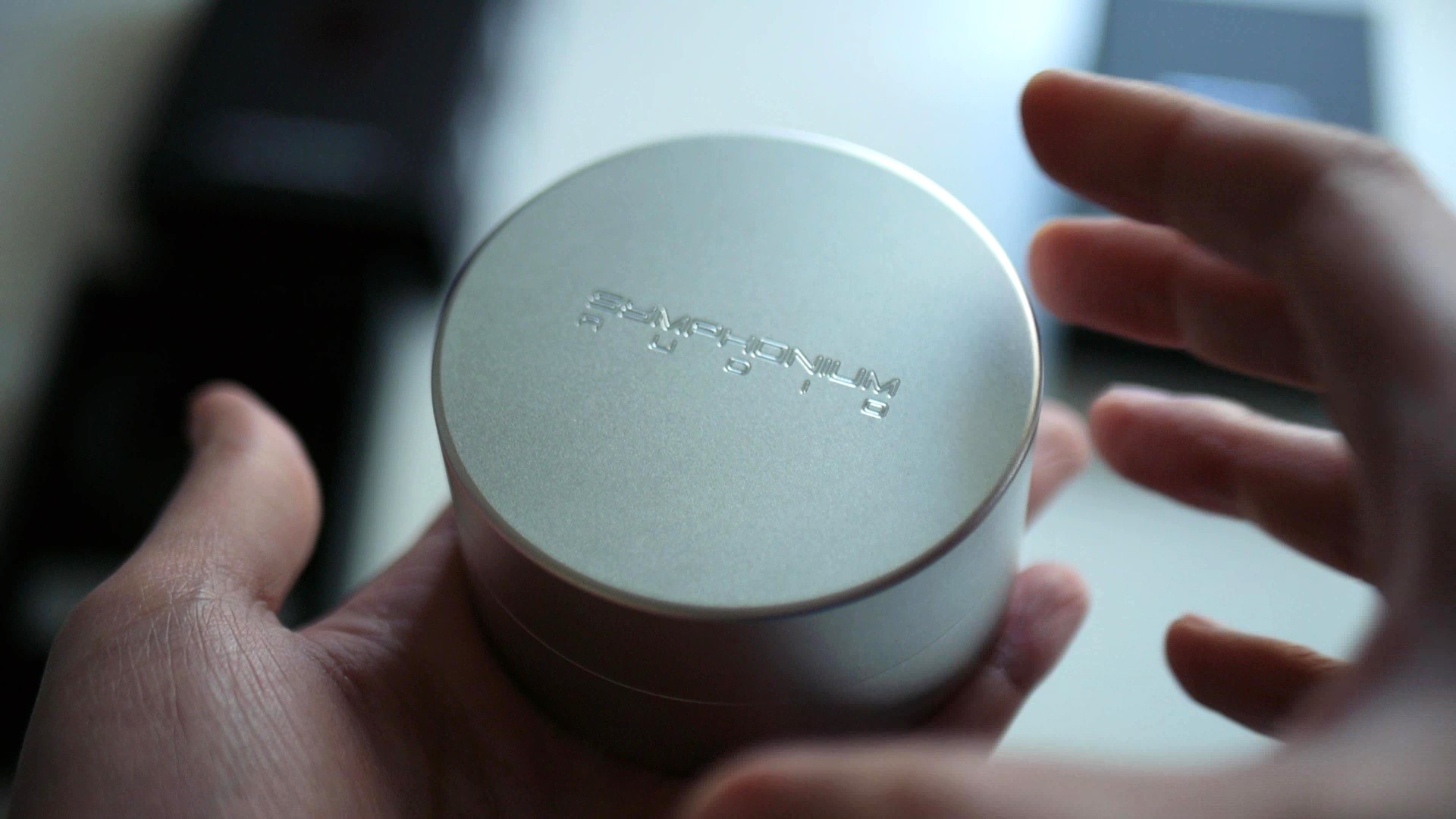
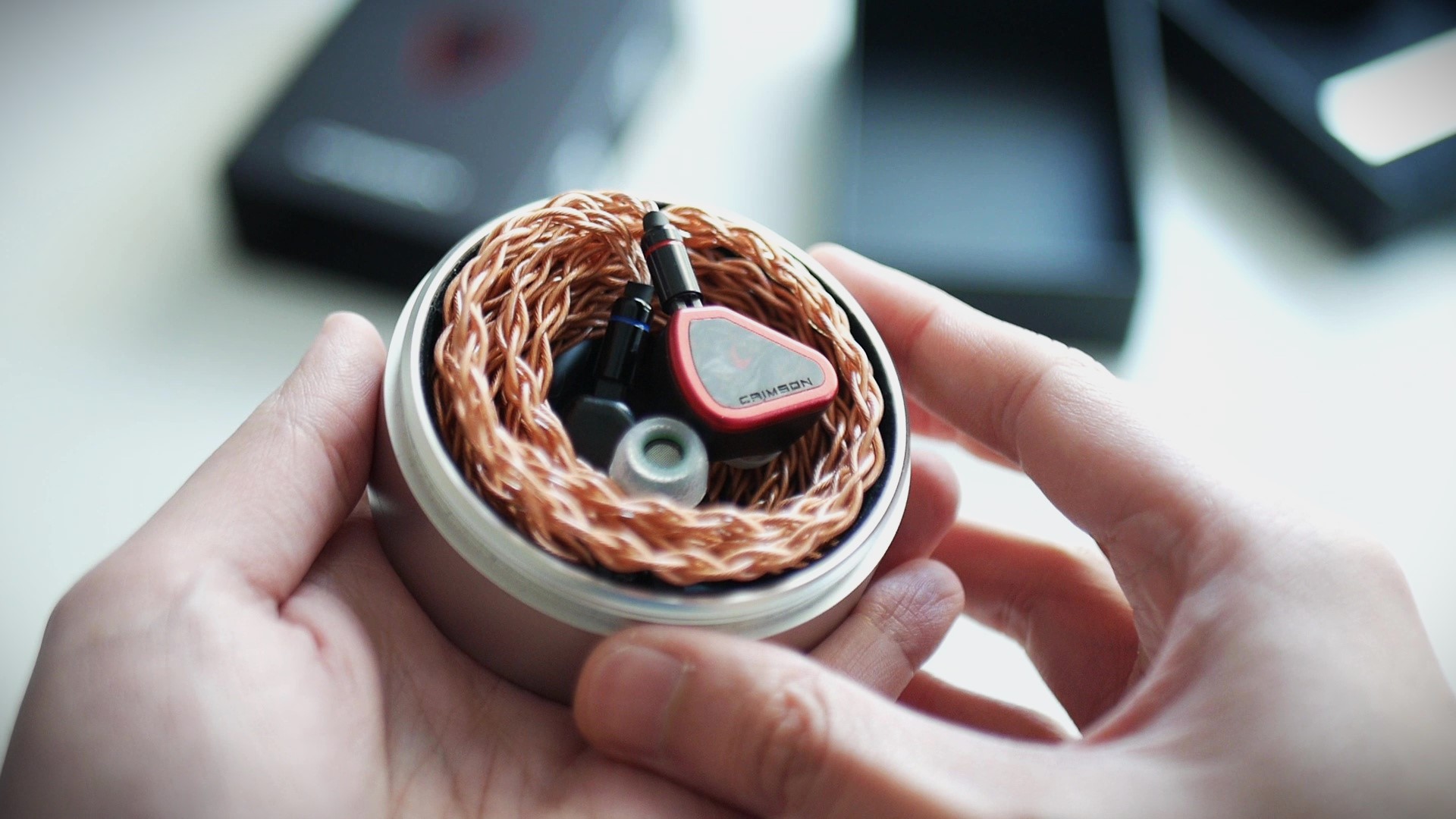
The earpieces of Crimson are encased in the same aluminium alloy material that was used by Helios. The size of the earpieces are also identical. However, Symphonium has made some adjustments to make the fit of Crimson much better than Helios. The most significant change was the reduction of nozzle length. No longer we have to tolerate long and thick nozzles to enjoy that sweet sweet treble extension.
The earpieces of Crimson are fully sealed. Therefore, depending on the type of ear tips that you use, there is a chance that you would encounter pressure build up (that stuffy, vacuum-sealed sensation in the ear canal that can be quite fatiguing). Fortunate for me, I did not encounter that problem during my tests. With either the medium Divinus Velvet ear tips supplied in the box or my own set of medium Sancai wide bore ear tips, the IEM seem to disappear in my ears even in longer listening sessions that last up to a few hours.
Because there is no dynamic driver inside Crimson, there has been no incidence of driver flex during my tests.
Ear tips recommendation: the choice of ear tips are very personal because our ears can be quite different. I found that Crimson sounds much better with short ear tips with wide opening. These tips allow me to minimize the length of the nozzles, which in turn smoothen the treble response. In fact, when I used the stock SEDNA ear tips, which extends the nozzles quite a bit and pushes the IEMs further away from my ear drums, I hear a noticeable treble peak that manifests in a high-pitch “hiss” at the top of higher vocals, cymbals, hats, and trumpets. This hiss and the corresponding harshness was gone when I switched to the Sancai ear tips.
Driveability
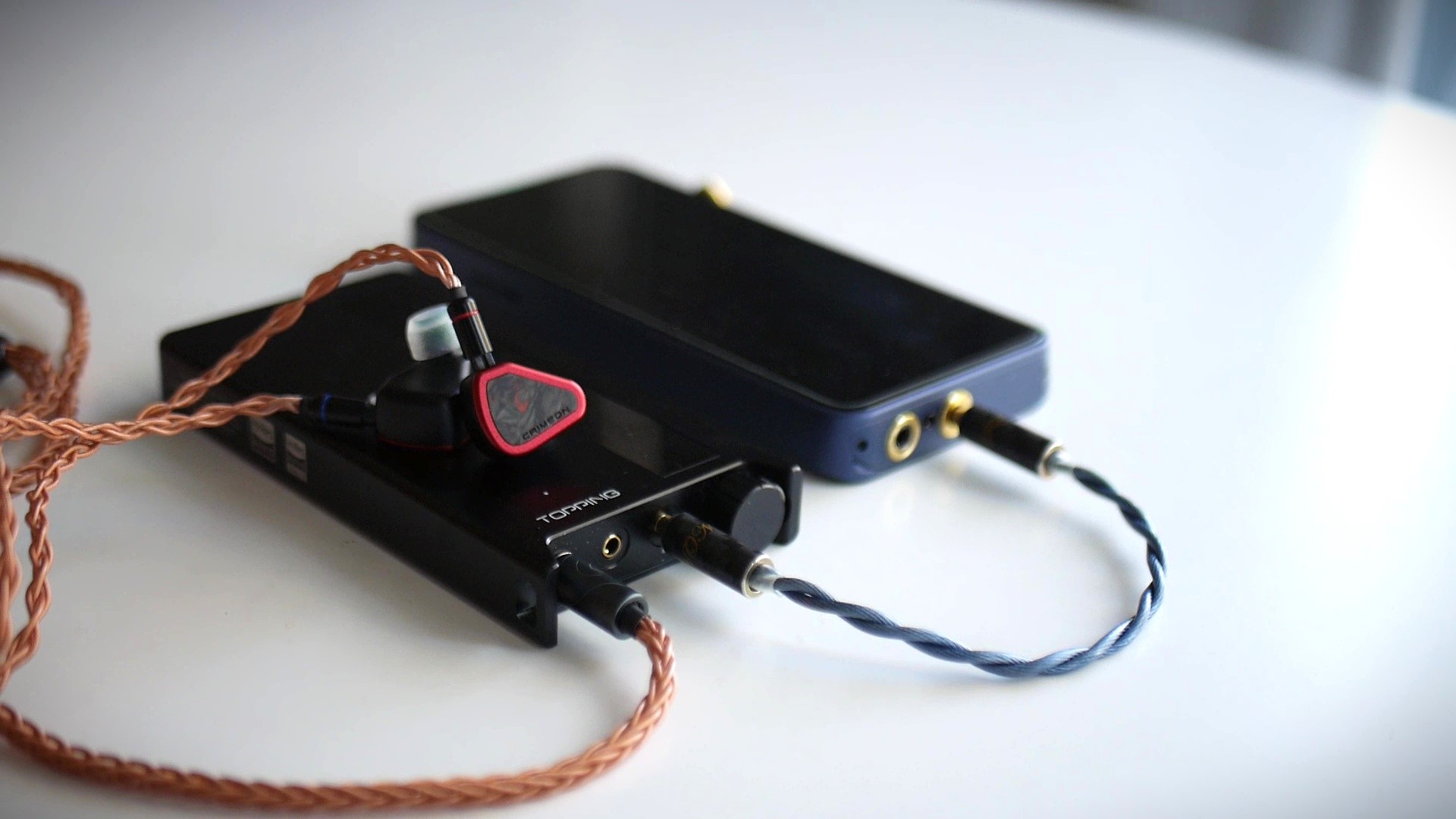
An IEM builder once told me that more complex crossover designs tend to make IEMs very difficult to drive. Crimson might be an example of this conjecture. With the impedance of 6.05ohm@1kHz and sensitivity of 106dB/Vrms@1kHz (83dB/mW@1kHz), Crimson is a very difficult IEM to drive indeed. You need an amplifier that can maintain stable current supply when facing large volume peaks (transients), especially when the peaks are in the bass region.
Usual disclaimer: when I say that an IEM is “difficult to drive”, it does not mean that I cannot get loud sound out of them from a weak amplifier. It means that that sound is noticeably more muffled, muddy, and more congested with these devices. In other words, a “difficult to drive” IEM does not sound very good without good amplification but can “scale” when paired with a stronger amplifier.
So, how difficult are we talking about?
The Apple’s USB-C to 3.5mm adapter (a.k.a., “Apple dongle” a.k.a., “all that you need”) at the maximum output can barely reach listenable volume when I listen to the album LIVE by Hans Zimmer. The bass is barely present. When a track forces the bass to appear, the bass lacks the crisp, snappy attacks and the texture is barely passable. Whilst the stage is properly wide, it feels 2D, lacking the near-to-far placement of instruments (depth and layering). Whilst it is not unlistenable, I can’t recommend this pairing unless you have nothing else on your hand. Interestingly, the Apple dongle got warm after a few songs.
Just for fun, I tried to drive Crimson with the headphone out of ASUS ROG Ally handheld gaming device. Again, the bass was weak and blurry. Interestingly, the sound started to distort at transient peaks in the music.
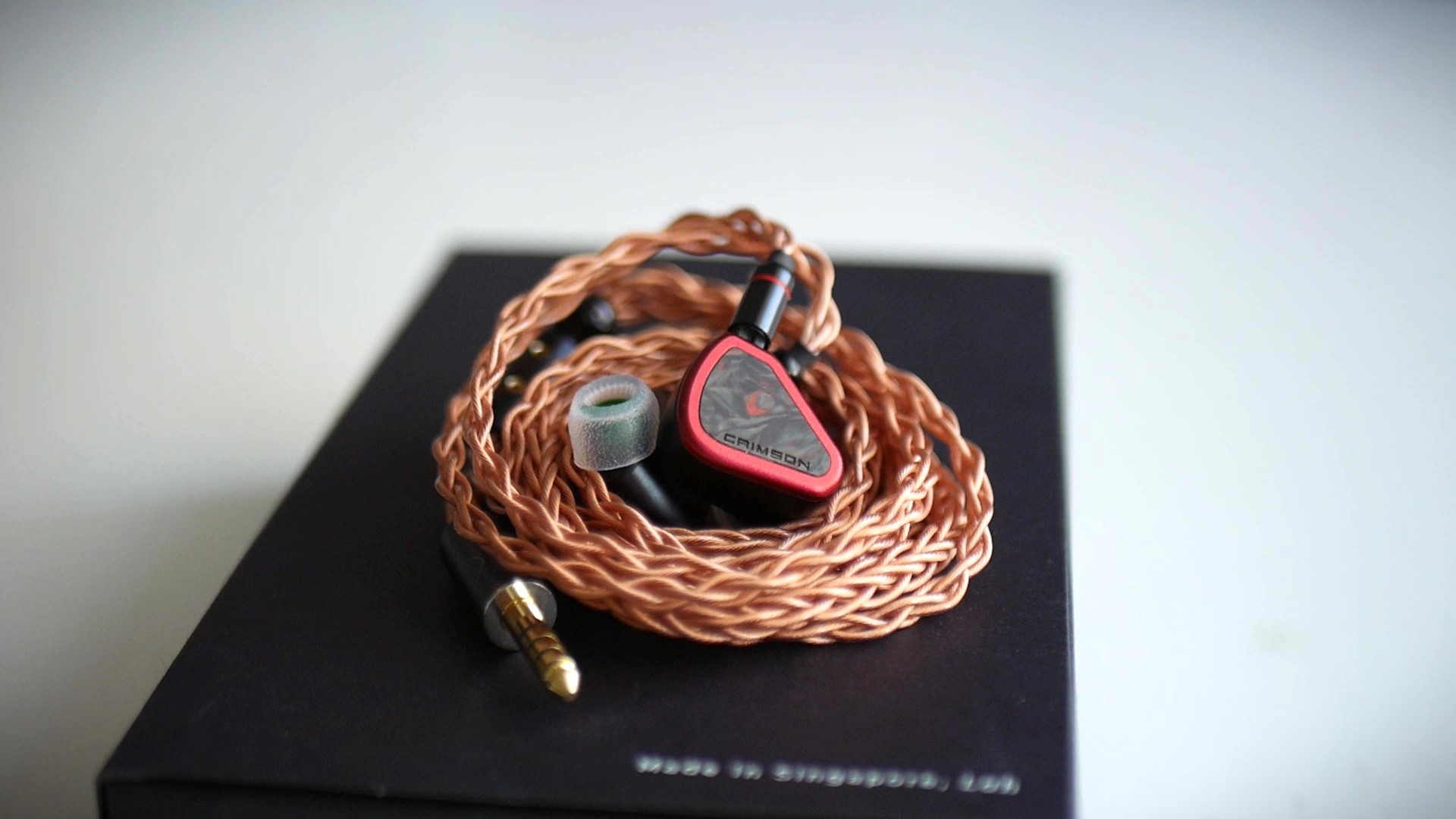
Upon switching to a good USB DAC (a.k.a., “dongles”) such as AFUL Snowy Night, two differences were immediately audible. Firstly, the bass becomes tight. Every bass kick in the Gladiator Suite has a snappy physical sensation somewhere in my throat, like a quick “jab” (no, it’s not as painful as it sounds). Simply put, the dynamic of Crimson is awaken: snappy, precise, and powerful. Secondly, the stage becomes noticeably more 3D. Now, there is not just left-to-right placement of instruments on a flat plane. I can easily hear the layering of different elements in the mix from closer to further away. The micro details of each instruments are also much easier appreciated as they are not blurred into each other like with the Apple dongle.
How far can we “scale”? For this test, I connected Crimson to my desktop DAC/amp combo FiiO K7, which can push up to 2000mW into a 32ohm load at 1% distortion. Yes, Crimson does sound better, particularly in terms of how large the soundstage be projected. Take the beautiful passage at around 2:06 in the Gladiator Suite Part 3 as an example. Whilst Snowy Night does a good job, the K7 does a better job, as if a “wall” that confines the outermost layer of the stage where the choral section sits was broken. The difference here is without a doubt a “refinement” rather than “correction” like the difference between Apple dongle and Snowy Night. However, it is substantial and consistent enough for me to report in this review.
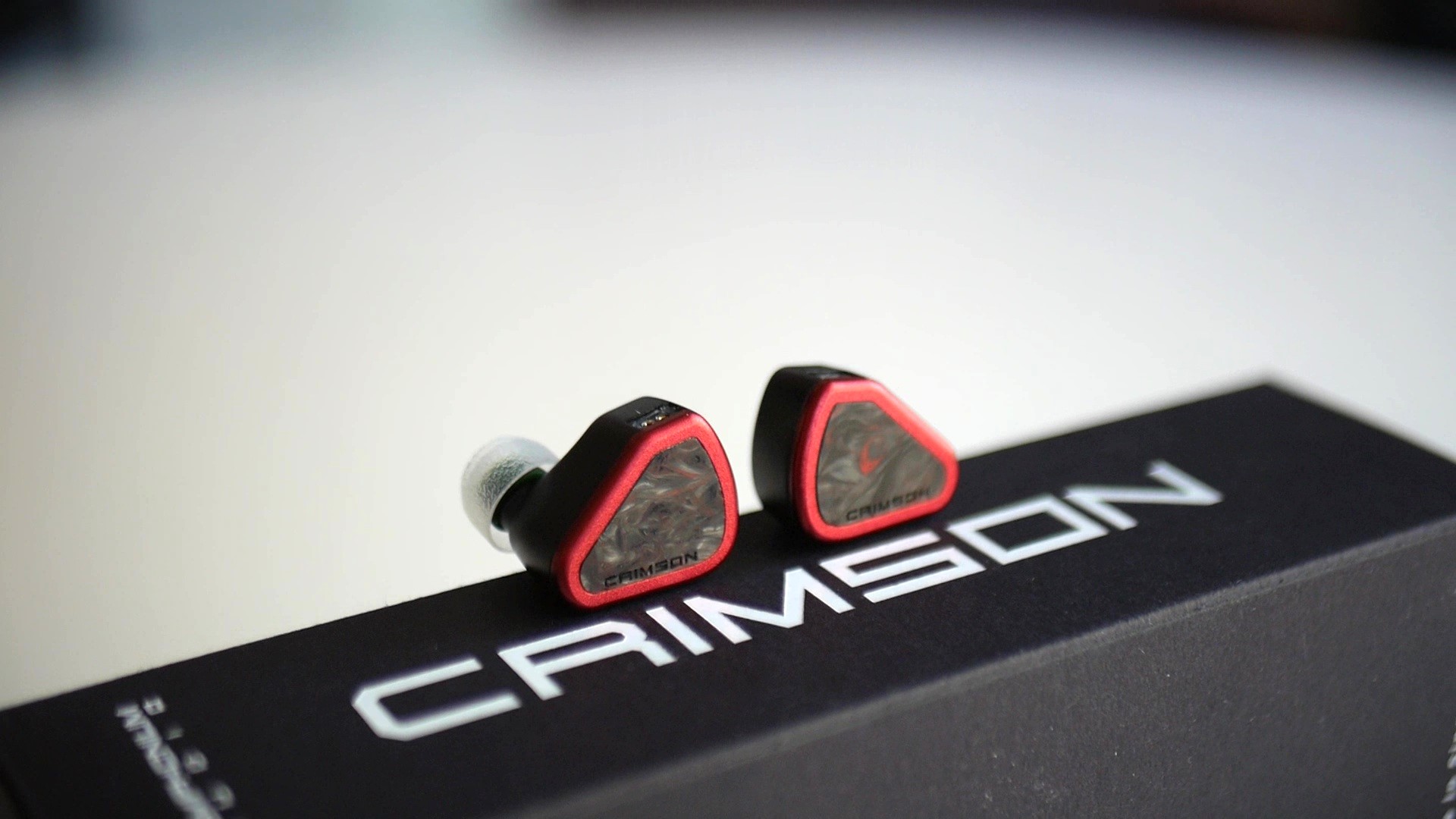
How about Digital Audio Player (DAP)? For this test, I rely on my iBasso DX300, an older TOTL DAP with four CS43198 (two more than the Snowy Night) and an amplifier that can deliver 1240mW into 32ohm load. The result was not unexpected. I heard an almost identical staging performance to that of K7, though the DX300 reveals some micro details that are much harder to hear on K7. Moving down to more modest DAPs like my trusty HiBy R3II reveals a “scaling down” in performance to roughly the level of a good dongle.
Before we move on, I would like to emphasise how revealing Crimson can be. For example, when I was going through my test tracks, there was a recording with clarinet and saxophone where I can hear details down to the air vibrating the reeds before and after the notes. It was unmistakably there when I listened with my DX300. Yet, even when I turn the volume way higher, I cannot hear those details with my K7. Does a bit micro details matter? Maybe not. But I was surprised when I hear the difference.
Subjective Experience
Testing setup:
- Sources: FiiO K7, AFUL Snowy Night, iBasso DX300
- Cable: stock 8-wire cable, 4.4mm connector
- Ear tips: Tangzu Sancai Wide Bore (Medium)
The overall signature of Crimson can be described as U-shape. What does that mean?
It means, to my ears, the midrange of Crimson is simply open and transparent. There is no additional warmth to add any “analogue glow” to make voices and instruments more pleasing. Crimson also does not pull back the upper midrange, so voices are placed upfront and intimate if the mix demands so. At the same time, Crimson does not have that “forced clarity” expressed by some IEMs with strong upper midrange emphasis, such as my Effect Audio Gaea. Perhaps, the best way to describe the midrange of Crimson is “disappearing.” Is it a good thing? To me, definitely.
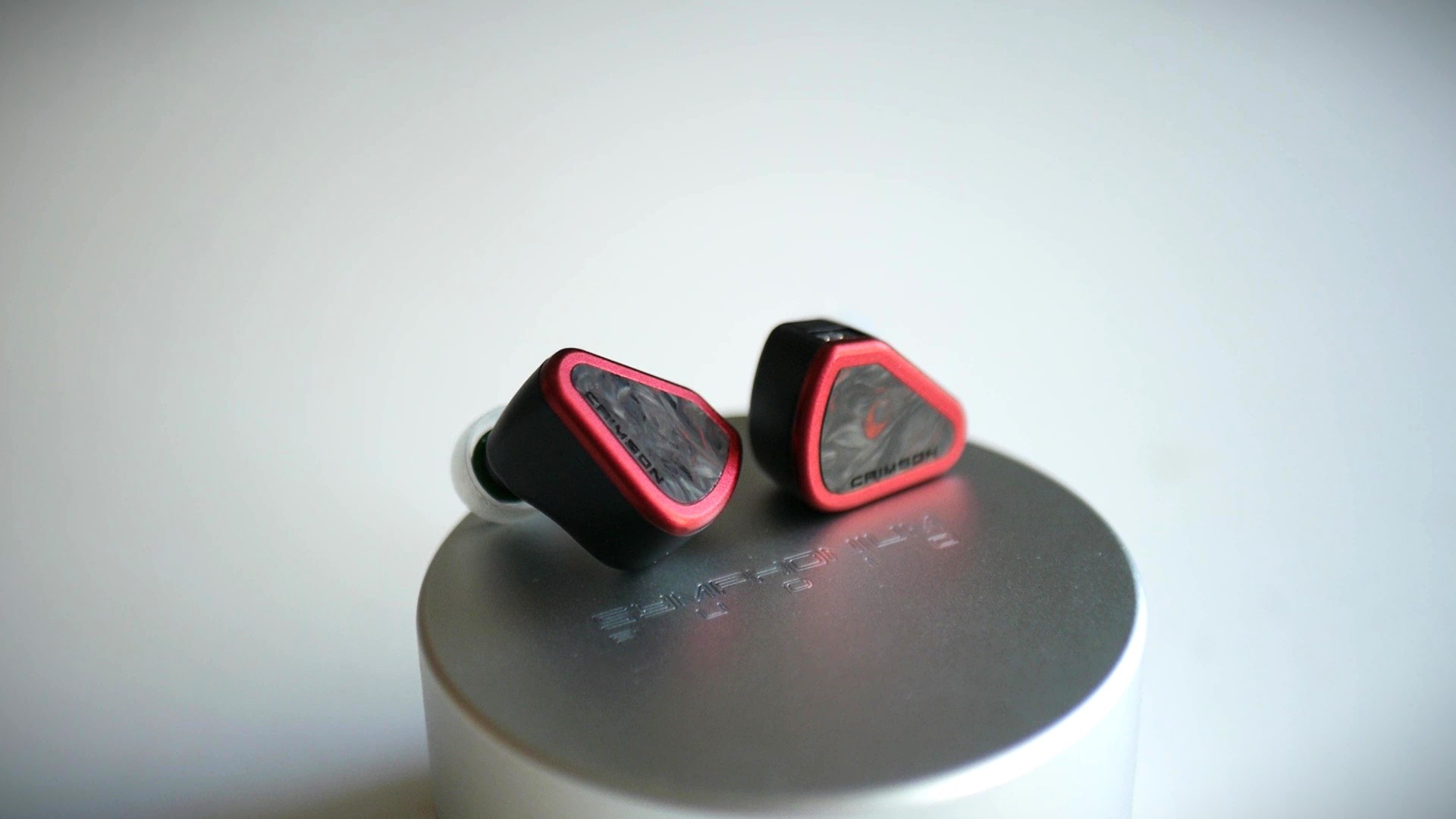
The neutral midrange is flanked by a strong bass shelf and an extended treble. Crimson maintains the clean bass shelf that focuses in the subbass, meaning this IEM can rumble. Fortunately, the dip in the midbass region (a.k.a., the bass punches), one of the most divisive design decision of Helios, was removed. As a result, the bass of Crimson is no longer kinda-odd-and-hollow like Helios. The amount of bass is also quite indulgent. With that being said, the bass response of Crimson is tight. The bass attacks feel snappy like whip cracks rather than big pillowy POOF like some IEMs with dynamic drivers, or even some 64 Audio IEMs like U12T.
The treble is where Crimson shines. But before we discuss treble further, I can’t emphasis enough the need to explore different ear tips to get these IEMs fit correctly. If the length of the tube from drivers to ear drums becomes too long (i.e., the IEMs hanging outside the ears), unpleasant treble harshness would appear.
When the fit is right, I can hear a smooth, well extended, and detailed treble response. High pitched instruments such as cymbals and hats are present yet not emphasised above the midrange, such as the singer and guitars. The stick impact of cymbals and hats are cleanly articulated. The body of the sound of cymbals and hats are full and nuanced, rather than simply splashes of high pitched noises. The decay of these instruments are extended and fully resolved until they disappear below the audible threshold, rather than being dropped off abruptly.
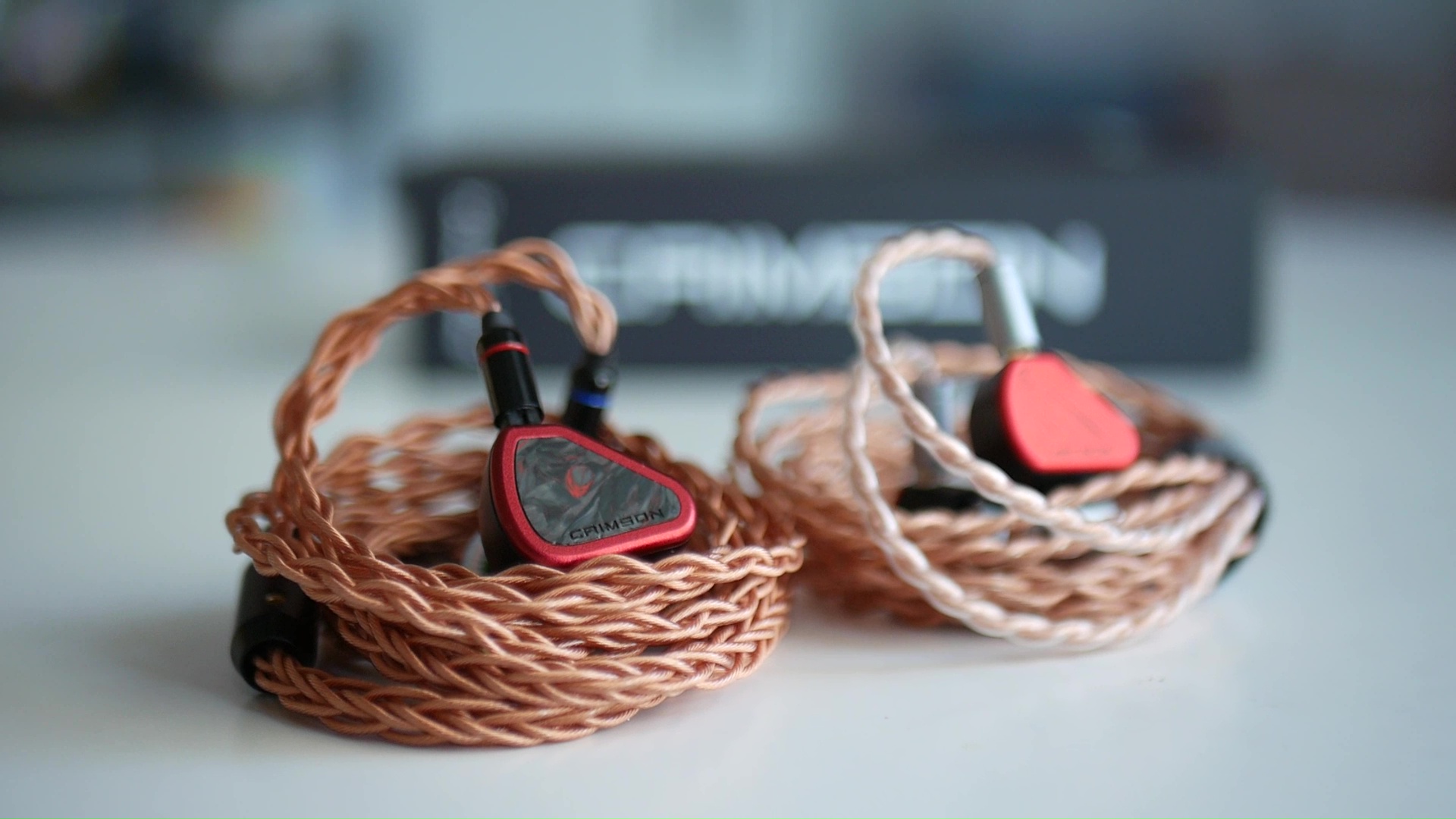
Another advantage of Crimson’s excellent treble extension is the ability to reveal micro details. For instance, when I listen to And the Waltz Goes On performed by Andre Rieu and his orchestra, I can hear much more details from the opening phrase of the saxophone, down the to the sound of the air going through the reed before and after a note. The reverberation in Bach: Goldberg Variations, BWV 988: Aria recording by Lang Lang is fully audible, crisp, and clear. Don’t get me wrong, the excellent detail retrieval is not just to brag that “I can hear the reed vibrating, can you?” That little bit of extra details is available to every elements in every recording, lending orchestral and live recording a palpable “realness.”
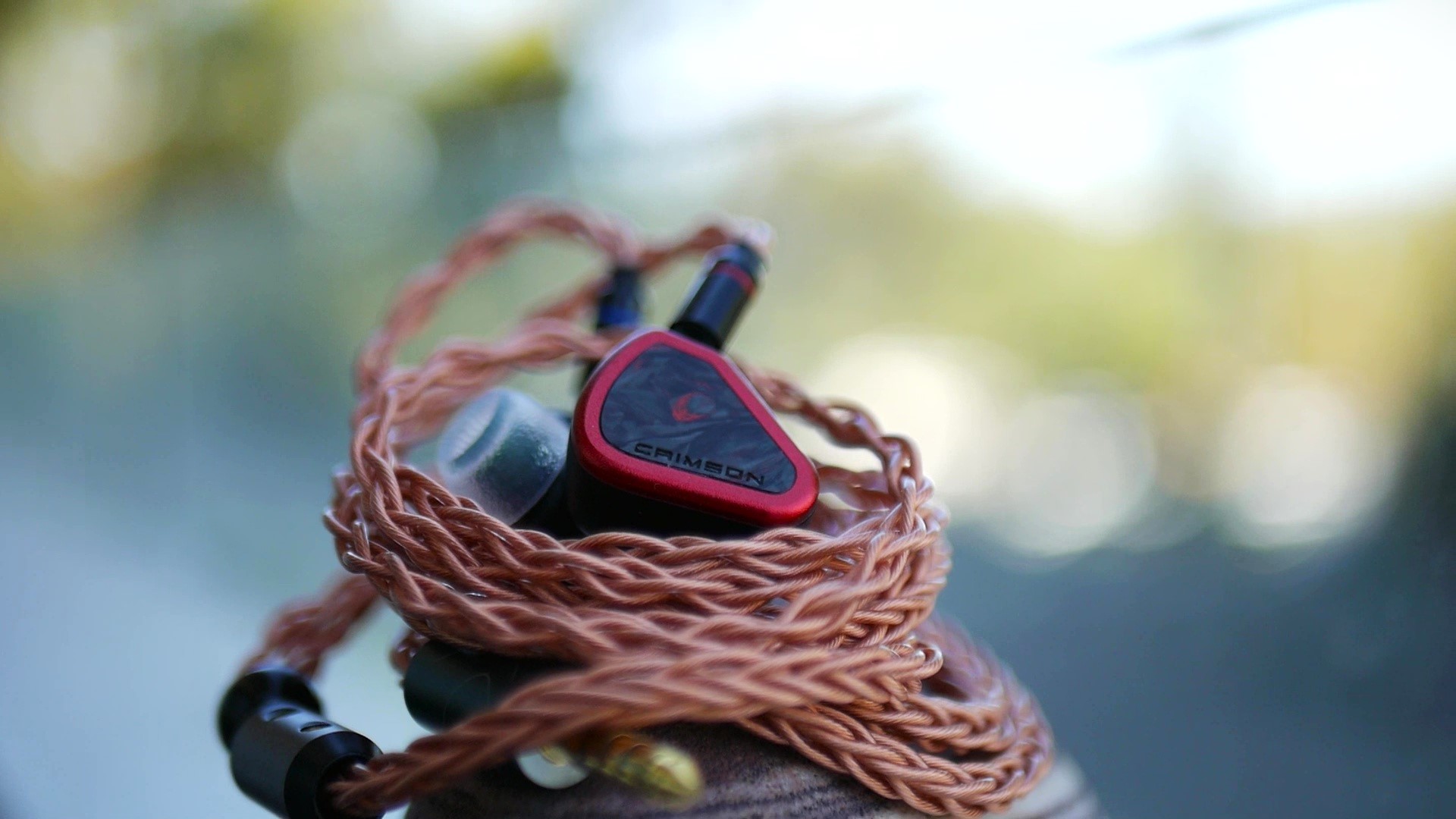
Excellent treble extension combined with careful channel matching together one of the biggest strengths of Crimson: soundstage imaging. If the sonic image is supposed to be large, misty and diffused like the opening of A Way of Life - The Last Samurai, Crimson can convey that. At the same time, it can pin point the direction and distance of the string that appears at around 1:17, like shining spot over the foggy misty ambience. Switching to Final Mission - Quantum Burst by Kenji Kawai, I hear a fully filled sound scape with different elements occupying their precise location, both left-to-right and near-to-far. The bass is upfront and centered. The strings are on the left but their reverb can smoothly pan to the right channel. The choral section around 0:54 seems to float higher up on the stage. The brass seems to be on the front-left, further away, behind the strings. Around 1:15, trumpets pop up close to the right ears. Around 3:00 the male choir comes in on the front-right, sounding distant and further into the background, contrasting against the busy foreground. I can go on and on. At this point, it’s my ability to note down the impressions and the resolvability of my source chain that create bottleneck, rather than the IEM itself.

FPS gaming is where the ability to reproduce spatial cues of Crimson truly shines. For example, CS-GO Gameplay by Throneful shows a large and spherical stage, making it easy to discern the distance of gunshots from all directions. When the sound comes from the sides, at times I feel like they come from outside the ears, around the shoulders. Still, most of the time the sound does not get out of the head stage, like most IEMs.
Frequency Response Analysis
Frequency response of Crimson against Helios and the Harman in-ear target. Measurements were done with an IEC-711-compliant coupler and might only be compared with other measurements from this same coupler. Above 8kHz, the measurement might not be correct. Visit my graph database for more comparisons.
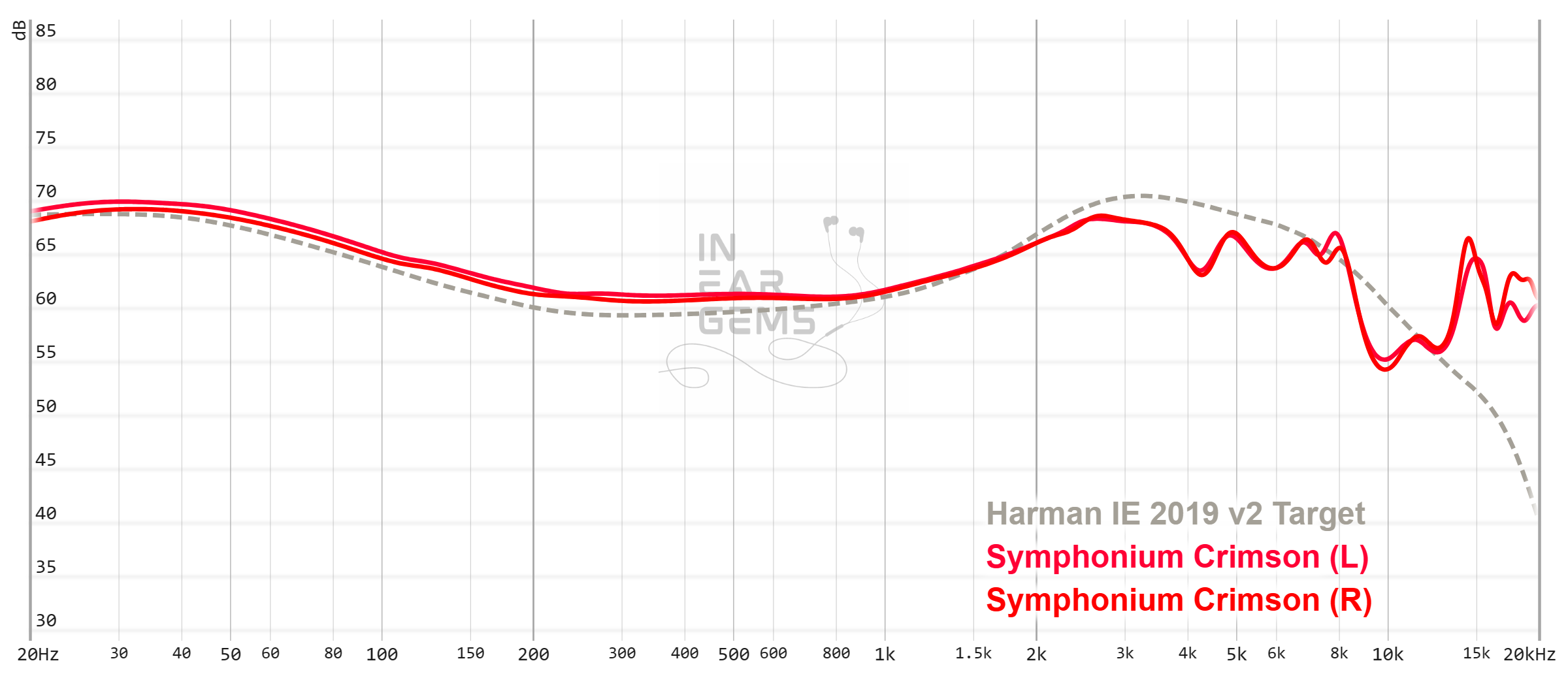
It is helpful to think of an IEM as a filter that highlights or subdues different parts of the incoming audio signal. This effect can be measured objectively by the squiggly lines above, called Frequency Response (FR) graphs, which measure how loud an IEM is at different frequencies from 20Hz (bass) to 20kHz (upper treble). Subjectivity is how your ears and brain interpret the effect of that filter on your music and decide whether it is “enjoyable.” There are some “rules of thumb” when it comes to tonality, but most interesting IEMs usually bend the rules masterfully.
The frequency response of Crimson brings a lot of joy to my inner geek. It roughly follows the Harman target where it makes sense, but make sensible adjustments where the target becomes questionable:
The dip around 250Hz that “detaches” the bass from the midrange and makes the bass impact mysteriously disappear in some recordings, a noted problem some “full Harman” IEMs and the Helios, was completely fixed. The bass shelf of Crimson glides down from 32Hz to join the midrange smoothly the midrange at 250Hz.
The midrange frequencies between 250Hz and 1kHz is ruler-flat. The upper midrange of Crimson shares the same tuning decision as that of Helios. In particular, Symphonium diverges from the Harman target at around 2.5kHz and keeps the response around 3dB lower than the target all across the upper midrange and lower treble region, mitigating the shrill and harshness that the target carries. Interestingly, the combination of a ruler-flat midrange and the milder upper midrange also ensures that Crimson does not sound unnaturally lean or bright.
It just works.
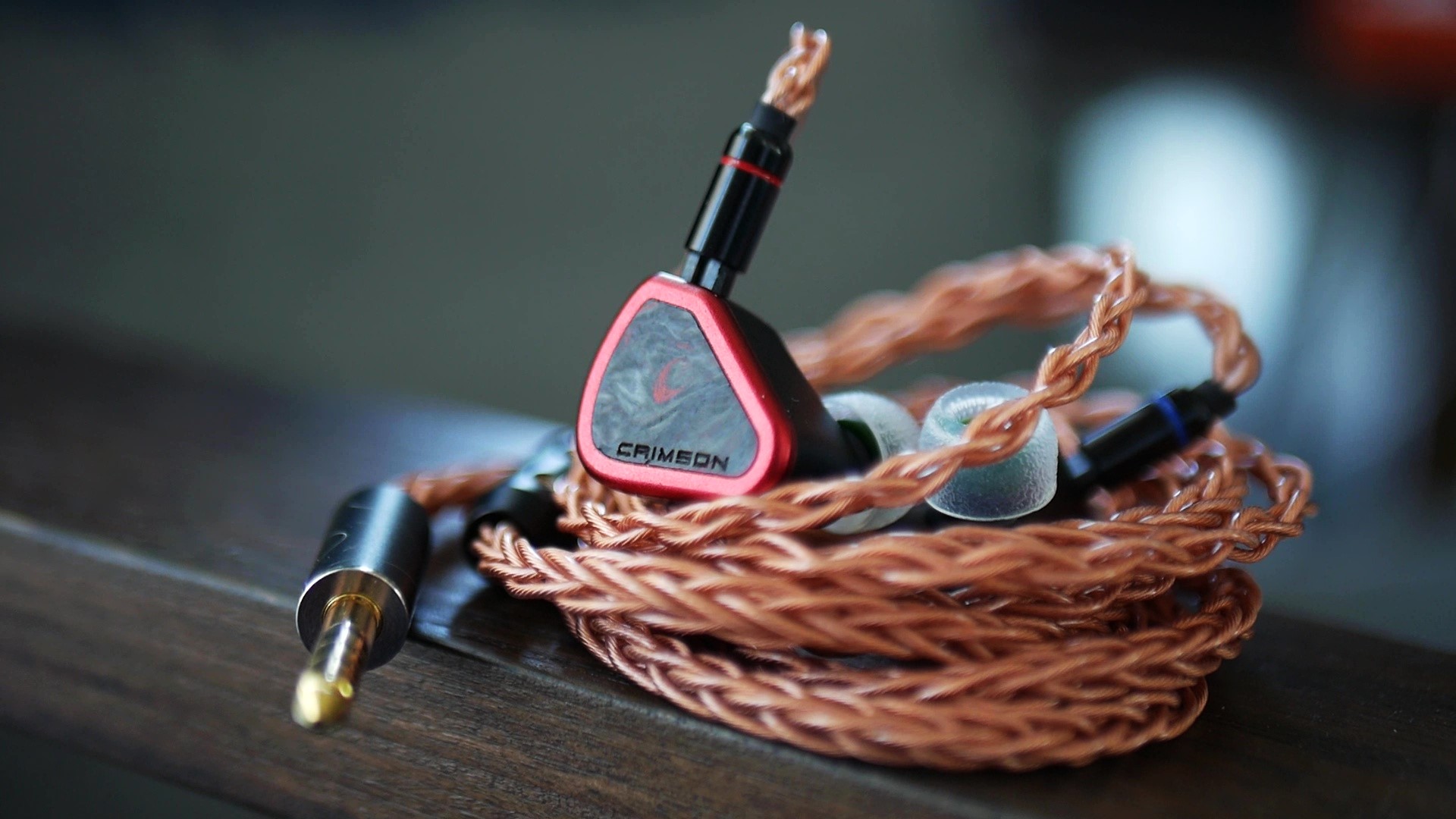
The high frequencies are where the confidence of my frequency response measurement drops because (1) anything above 8kHz is likely not 100% correct and (2) how one wears the IEM can introduce significant variations in this region. When I compare my measurement of Crimson with the official graph of Symphonium, I found that all the peaks and dips are roughly the same, but my valley at between 10kHz and 12kHz is at least 3dB more extreme.
Regardless of the graph, Crimson has excellent treble extension, helping it to localise the sound precisely on the soundstage and resolves details down to the minutes that my DAC and amp can reveal. And what is nice is that Crimson does not have a peak somewhere around 12kHz like my U12T that can be fatiguing in some recording. To ensure the best treble extension and minimize the risk of treble peaks, I would use wide bore tips and wear the IEM as deep as I can.
Resolution

Resolution is a fascinating subject due to the difficulty of pinning down what it really is. To me, “resolution” can be broken down into three components: (1) Sharpness, incisiveness, or “definition” of note attacks (see the figure above). (2) The separation of instruments and vocals, especially when they overlap on the soundstage. (3) The texture and details in the decay side of the notes. The first two give music clarity and make it easy to track individual elements of a mix. The last provides music details and nuances. Smooth and well extended treble response plays a crucial role.
If I were to describe the resolving ability of Crimson in one word, it would be “effortless.” Given a well produced recording, Crimson makes it easy for me to hear everything. Instruments have precise boundary and strong clarity, likely due to the proper energy in the upper midrange. Micro details are there. If a recording was mixed with reverberation, I would be able to hear it clearly.
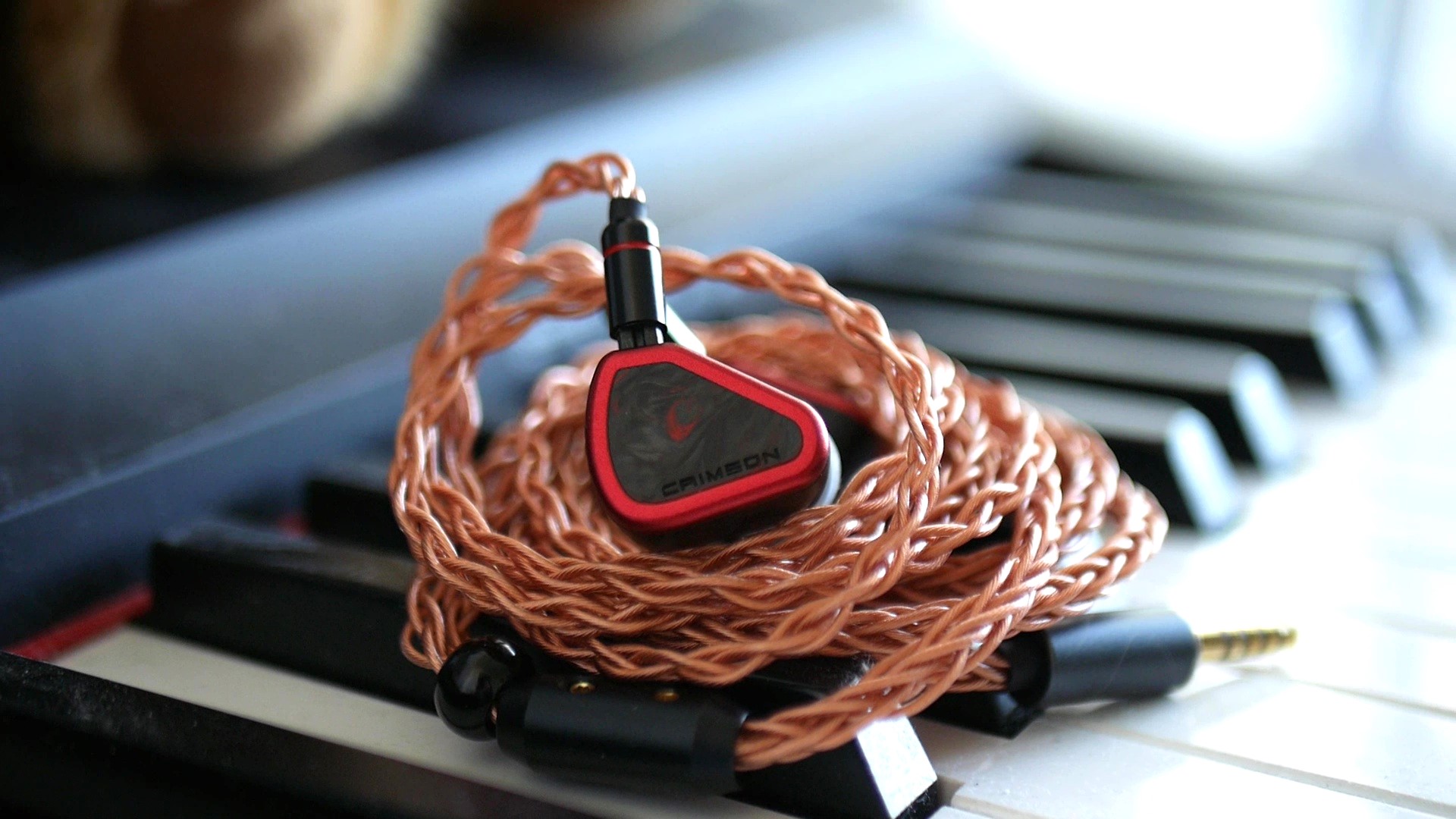
So, we know that Crimson is resolving. But how resolving?
For this test, I’m pitching it against my trusty U12T and Gaea. The most interesting observation, to me, was the contrast between the naturally detailed presentation of Crimson and U12T against the “forced clarity” of Gaea. For example, when I listen to A Way of Life - The Last Samurai, instead of a misty and somewhat distant presentation (at times), the way Gaea presents this recording reminds me of a photo that has been processed with the exposure and clarity sliders cranked up. Everything is brighter, more upfront, and indeed clearer, but not quite “right.” But I digress, let’s go back to Crimson. The Symphonium IEM has the brightness that sits between U12T and Gaea. Despite not pushing everything forward, Crimson shows more nuances and details, especially in the decay end of the notes comparing to Gaea. The Crimson and U12T trade blows on everything, from separation, instrument placement, to micro details.
Soundstage Imaging

Stereo imaging or “soundstage” is a psychoacoustic illusion that different recording elements appear at various locations inside and around your head. Your brain creates based on the cues in the recording, which are enhanced or diminushed by your IEMs, your DAC, and your amplifier. Some IEMs present a wide but flat soundstage. Some present a “3D” soundstage with layering, depth, and height. In rare cases, with some specific songs, some IEMs can trick you into thinking that the sound comes from the environment (a.k.a., “holographic”)
Crimson has the ability to project a large and 3D soundstage with good width, depth, and height, if such information is embedded in the recording. The strength of this IEM lies in precision. As I mentioned earlier, thanks to the treble extension, with the right recording, the instruments can have such “realness”, as if they are 3D blobs in space that I can mentally reach out and grab them.

Still, I need to control the expectation here: Crimson is an IEM. Having a “large soundstage” does not mean that it would sound like listening to a pair of floor speakers in a living room. It also rarely makes a sphere of sound around the head like a pair of open back headphone. Instead, the virtual picture of the sound painted inside the head feels larger and more 3D than other IEMs and sometimes, in rare cases, can break the head stage to create the illusion that sound comes from the room. If you approach Crimson, or any IEM for that matter, with the expectation of speakers or headphones, you would find whatever soundstage these IEMs project negligible. If you approach from an IEM perspective, the stage here is quite impressive.
How good, you might ask?
I would say the overall expansion of the stage is identical to my trusty U12T. However, the distribution of instruments on the stage is different. The U12T has more density at the middle of the stage, whilst the Crimson distributes the instruments more evenly.

I also had the pleasure to compare the Crimson against the Noble Audio Spartacus, a cutting edge 6-driver IEM with 2 Sonion bone conductors. Again, I hear a similar expansion of the stage, but Spartacus has even more density at the middle of the stage than U12T, giving it a focused presentation. At the same time, possibly thanks to the bone conduction drivers, or (more likely) some treble emphasis around 8kHz region, this IEM can push some elements in the mix way higher than both Crimson and U12T, as if they come from above my ears.
Comparisons
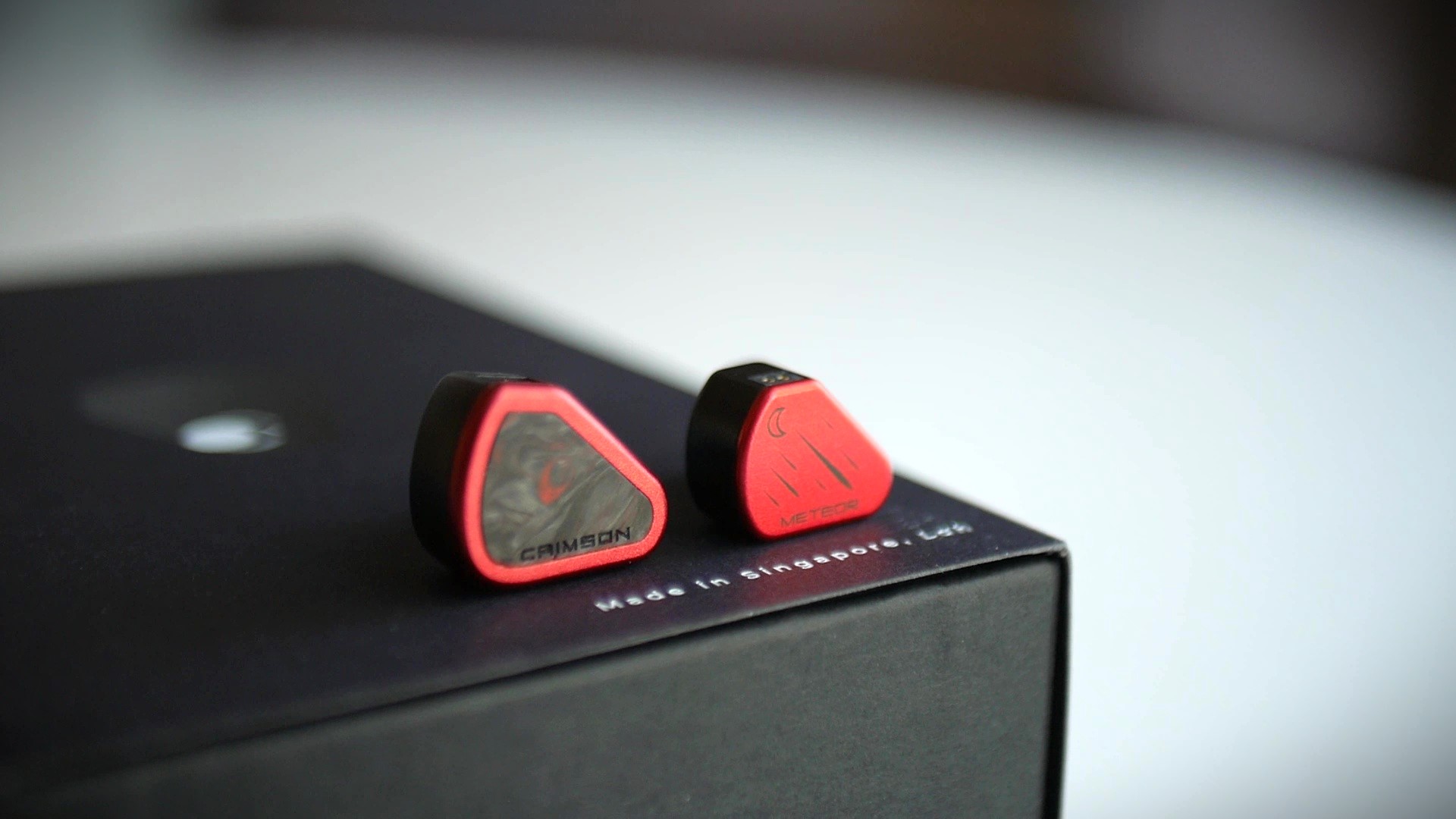
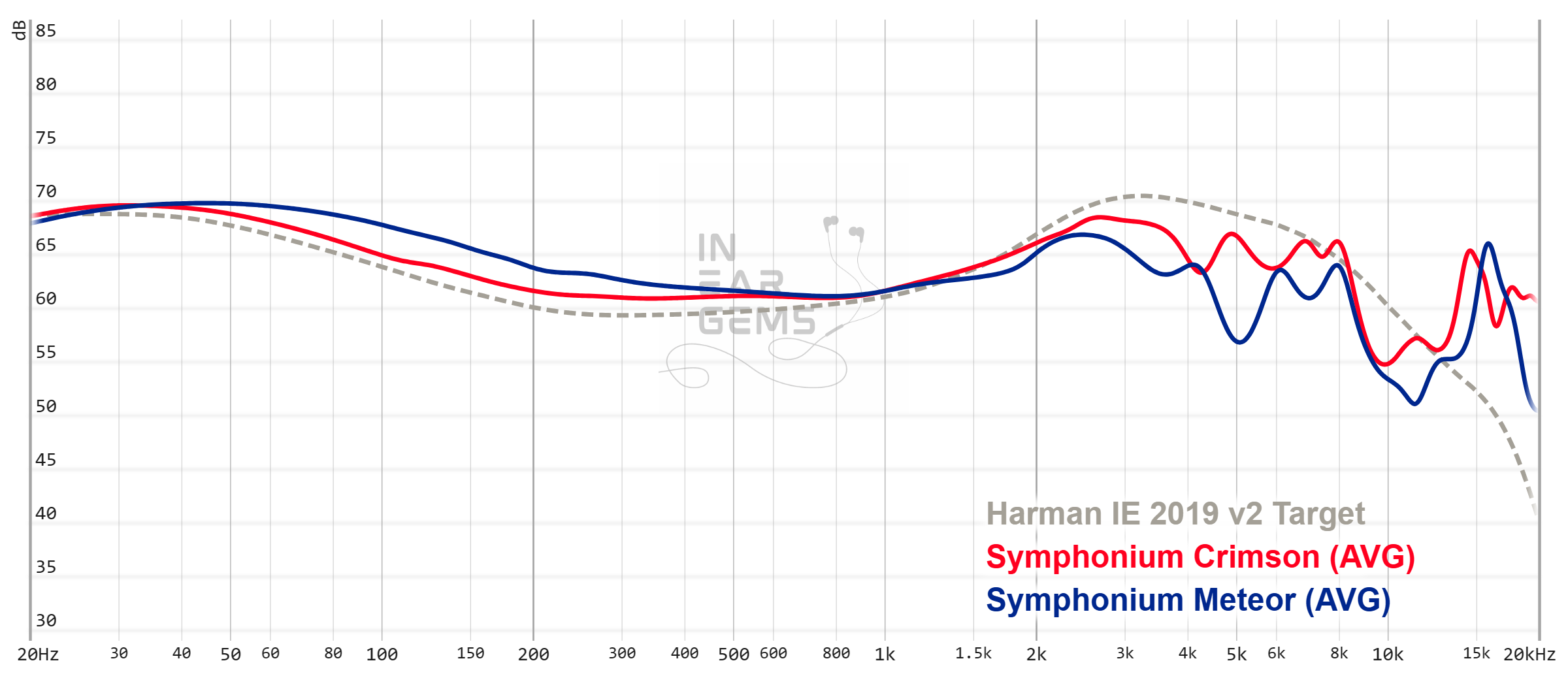
Vs Symphonium Meteor: 4 drivers vs 4 drivers. PHAT vs PHAT. Symphonium vs Symphonium. These IEMs have more similarity than what one might expected. Both have excellent treble extension that brings a “special effect” to the way they project stereo images. Both have surprisingly great bass despite using BA woofers. Both have great dynamic (loudness swings) However, Meteor has a slightly warmer midrange whilst Crimson is more transparent. The bass punch of Meteor also that “poofy”, rounded attacks that can feel as if there is air being pushed. Meanwhile, Crimson’s bass is snappy. The clarity and separation of Meteor is also a few step behind Crimson.
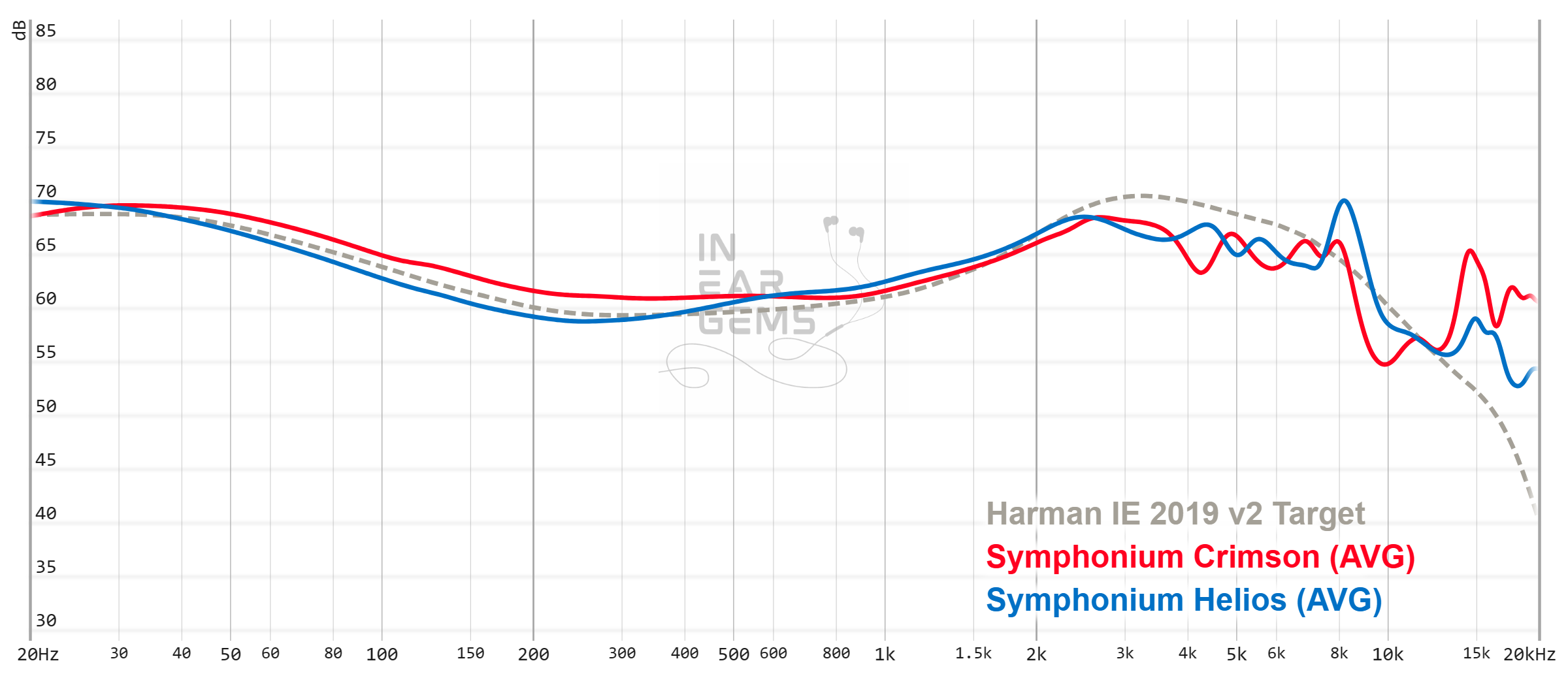
Vs Symphonium Helios (from memory): The most noticeable differences between these IEMs are tonal balance and fit. Thanks to the shorter nozzle, Crimson is much easier to wear and much more comfortable than Helios. Tonality of Crimson is also easier to enjoy than Helios, at least to me, thanks to the removal of the dip at 250Hz. Resolution, particularly detail retrieval and separation, was another clear advantage of Crimson. Whilst Helios’ resolution can match or surpass some strong kilobuck performers, it fell a bit short in A/B tests against the likes of U12T. It’s no longer the case with Crimson.
Vs Noble Audio Spartacus: The tonality of Crimson and Spartacus are quite different from each other. Crimson’s midrange is all about neutrality, transparency, and openness. The midrange of Spartacus is thick, warm, and densely focused in the lower region. The bass of Crimson focuses on subbass energy and snappy attacks. The bass of Spartacus is more about thick, puffy midbass punch. Due to the tuning choice, Crimson and Spartacus present the soundstage quite differently. With Spartacus, all the energy of the stage and distribution of instruments focus thickly around the center. The Crimson has a more even distribution across a sphere. However, the Spartacus can convey an uncanny sense of height, which is unmatched by both Crimson and U12T. Resolution-wise, the difference between these high performers are quite small.
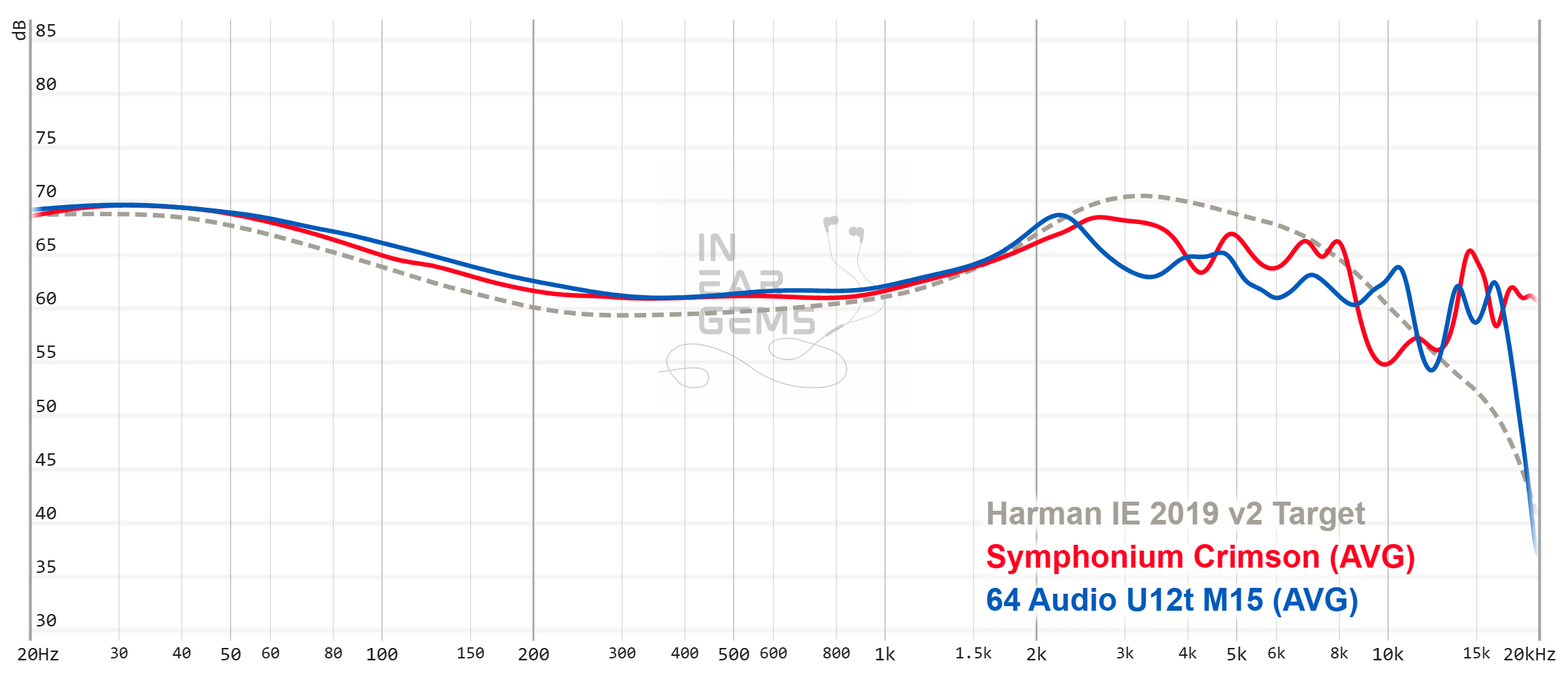
Vs U12T: To me, Crimson is a more energetic U12T. The bass of U12T is more rounded and rich, whilst the bass of Crimson is snappy. Both have enough subbass to convey a physical sensation. The upper midrange of Crimson is more emphasised, making vocals more forward with stronger clarity. The upper midrange of U12T has a dip around 3kHz, making vocals more easy going and more likely to break the head stage to appear somewhat in front of me. The stereo imaging capability and resolution of these IEMs are mostly identical. I would reach for either depending on the mood. Though when I play games with my handheld consoles, I would use U12T because it is much easier to drive.

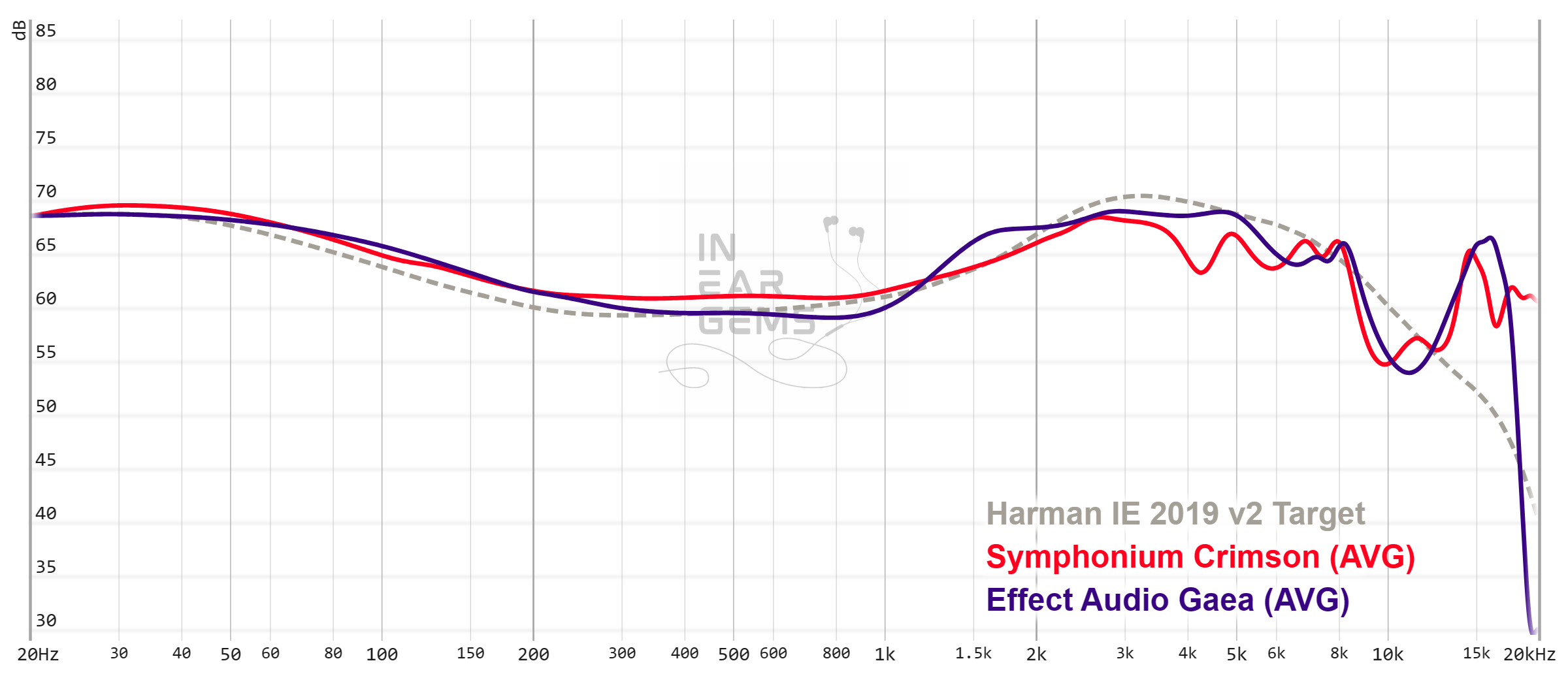
Vs Effect Audio Gaea: Whilst Crimson might feel bright on its own, it sounds quite ordinary next to the Gaea. Simply put, the tonality of Crimson is smack dab in the middle of “neutral” midrange, whilst Gaea stretches the boundary of upper midrange and lower treble, as if Elysian try to see how far they can increase the perceived clarity until the tonality becomes compromised and stop just before that happens. Regarding the resolution, I find that the Crimson does a better job, though at this high-end level, the gap is quite small. Regarding soundstage imaging, I find that the Gaea pushes the center of the soundstage where most actions happen more up-front, making the stage feels somewhat shallower than Crimson. Regarding macro dynamic, the ability to convey explosive volume swings that make music exciting, Crimson and Gaea trade blows.
Rating and Conclusion

So, what’s is the conclusion about Crimson? As usual, “it depends.”
If you want your music to be smooth and mellow with big, slow, enveloping bass, or if you primarily to music that is already energetic and edgy, perhaps Crimson would be too much for you.
However, if your idealisation of the “perfect” sound is the one with tack sharp instrument placement, snappy transient response, plenty of details, and a balanced U-shaped sound signature, if you listen to a lot of large orchestral music and soundtracks, then the answer is simple. Crimson is perhaps the closest to that “perfect” sound as it gets, without jumping into the abyss also known as “Top of the Line.”
What I like about this IEM:
- Laser-sharp instrument separation and layering
- Outstanding detail retrieval
- Immersive and 3D soundstage and imaging
- Snappy and exciting transient response
- Subbass rumble and texture
- Tonality is spot on
What could be improved:
- Upper treble can become harsh with a shallow fit
- Stock tips might not provide the necessary deep fit to avoid treble hashness
- Can be demanding in terms of the DAC/amp to pair with it
Absolute Sonic Quality Rating: 5/5 - Outstanding
Bias Score: 5/5 - I love this IEM!
